lordroel
Administrator
Member is Online
Posts: 68,107 
Likes: 49,494
|
Post by lordroel on May 26, 2021 2:56:50 GMT
Day 991 of World War II, May 26th 1942Eastern FrontBattle of Kharkov - Soviet troops continue attempting to breakout East towards the Soviet lines, but only advance 1 mile to the town of Lozovenka. Germans squeeze the surviving Red Army soldiers into an area of 15 square kilometers Battle of the Atlantic 780 miles Northeast of Iceland, U-703 attacks convoy PQ-16 hitting American SS Syros with 2 torpedoes, exploding ammunition in the 6390 tons of general war cargo. SS Syros breaks in 2 and sinks within 80 seconds (9 killed, 30 survivors picked up from the freezing sea by British minesweeper HMS Hazard but 2 die of exposure). Luftwaffe attacks on the convoy are unsuccessful. Photo: HMCS Restigouche May 1942 Battle of the Caribbean Battle of the Caribbean125 miles Northwest of Montego Bay, Jamaica, U-103 sinks American SS Alcoa Carrier carrying 6500 tons of general cargo (all 35 hands escape in 2 lifeboats; 33 picked up 4 days later by a Cuban gunboat and 2 by a US Navy aircraft). At 11 AM in the Gulf of Mexico, U-106 sinks US tanker SS Carrabulle carrying 42,307 barrels of liquid asphalt (22 killed, 18 survivors picked up 15 hours later by American steamer SS Thompson Lykes). In the Gulf of Mexico, U-106 stalk American SS Atenas and the 2 ships exchange gunfire (U-106’s deck gun is out of order, so the 37 mm anti-aircraft gun is used instead). 7 holes in SS Atenas’ hull are plugged and 2 small fires are extinguished, allowing her to proceed to Cristóbal, Panama. North African campaignLibya - while the British lay elaborate plans for their coming offensive, Rommel’s aims are simpler. He wants to get his tanks around the Allied defensive line to create havoc in their rearguard areas. Previous experience suggests this will precipitate an Allied flight back into Egypt, allowing Rommel to capture Tobruk. At 4 PM, after intensive bombing from German and Italian aircraft to break up the minefields, General Ludwig Crüwell attacks along the coast near Gazala with 4 Italian infantry divisions and some German motorized infantry. But this is a feint by Rommel; Crüwell has no tanks, only small aircraft engines mounted on trucks to stir up a massive dustcloud. While British General Ritchie congratulates himself for having place most of his infantry near the coast road to prevent a direct drive on Tobruk, all Rommel's tanks (German 15th and 21st Panzer and 90th light Divisions, plus Italian Ariete Division) are poised to attack around the Southern end of the Allied line. United Kingdom Lieutenant General Henry H "Hap" Arnold, Commanding General USAAF; Rear Admiral John H Towers, USN, Chief of the Bureau of Aeronautics; and RAF Air Chief Marshall Sir Charles F Portal attend an Anglo-American air conference in London. Topics of discussion include allocation of aircraft and the establishment of US air forces in the UK. The meeting begins at 10 Downing Street with Prime Minister Winston S Churchill. United Kingdom/Soviet Union relations Photo: A general scene showing delegates enjoying a walk in the gardens of 10 Downing Street, following the signing of the Anglo-Soviet Alliance. Left to right, they are: Mr Sabolev, Mr Papov, Ivan Maisky (Soviet Ambassador to London), Anthony Eden (British Secretary of State for Foreign Affairs), Molotov (Soviet Foreign Secretary), Prime Minister Winston Churchill, and an unidentified naval officer United States Photo: The U.S. Navy aircraft carrier USS Wasp (CV-7) entering Hampton Roads, Virginia (USA), on 26 May 1942. The escorting destroyer USS Edison (DD-439) is visible in the background United States Photo: The U.S. Navy aircraft carrier USS Wasp (CV-7) entering Hampton Roads, Virginia (USA), on 26 May 1942. The escorting destroyer USS Edison (DD-439) is visible in the background Photo: The U.S. Navy heavy cruiser USS Louisville (CA-28) off the Mare Island Naval Shipyard, California (USA), on 26 May 1942 Photo: The U.S. Navy heavy cruiser USS Louisville (CA-28) off the Mare Island Naval Shipyard, California (USA), on 26 May 1942 Pacific War Pacific War MIDWAY ISLANDS OPERATIONS The Japanese 1st Carrier Fleet, under Admiral Nagumo, leaves the Inland Sea to begin their part in the Midway operation, known as MO. US Naval TF 16, carriers Enterprise and Hornet, return to Pearl Harbor from the South Pacific. Photo: USS Enterprise at Ford Island, Pearl Harbor, May 1942. Shortly before battle of Midway Photo: USS Hornet (CV-8) at Pearl Harbor, May 26, 1942, just after the Battle of Coral Sea, and just before the Battle of Midway. Harbor tug Nokomis (YT-142) is underway alongside her. Note paint chipped off Hornet's waterline area by wave action while at sea. Photo: USS Hornet (CV-8) at Pearl Harbor, May 26, 1942, just after the Battle of Coral Sea, and just before the Battle of Midway. Harbor tug Nokomis (YT-142) is underway alongside her. Note paint chipped off Hornet's waterline area by wave action while at sea. The aircraft ferry USS Kitty Hawk (AKV-1) arrives at Midway Island with Marine reinforcements including a detachment of a 3-inch (76.2 mm) antiaircraft group of the 3d Defense Battalion, a light tank platoon and additional personnel for Marine Air Group Twenty Two (MAG-22). Photo: The U.S. Navy aviation transport USS Kitty Hawk (APV-1) at Ford Island, Pearl Harbor in early 1942. Note the bow of a Yorktown-class aircraft carrier on the left ALASKA (11th Air Force): 11th Fighter Squadron, 28th Composite Group, based at Elmendorf Field, Anchorage, Territory of Hawaii sends a detachment to Umnak, Aleutian with P-40's. JAPAN Citing Japanese victories in the Coral Sea and other battles, Radio Tokyo announces that "America and Britain... have now been exterminated.. the British and American fleets cannot appear on the oceans."
|
|
lordroel
Administrator
Member is Online
Posts: 68,107 
Likes: 49,494
|
Post by lordroel on May 27, 2021 2:50:47 GMT
Day 992 of World War II, May 27th 1942Eastern Front Battle of Kharkov - Germans continue reducing the Soviet forces trapped in the Izium pocket and snuff out the Eastward breakout, recapturing the town of Lozovenka. Battle of the Atlantic Luftwaffe attacks convoy PQ-16 all day. British SS Lowther Castle is sunk by He111 torpedo bombers. Ju-88s sink American SS Alamar & SS Mormacsul, British SS Empire Purcell & British CAM ship Empire Lawrence. Several other ships are damaged including Polish destroyer Garland & American SS City of Joliet, which sinks the following morning. In the North Sea 43 miles East of Great Yarmouth, British minesweeper HMS Fitzroy hits a British mine and sinks (12 killed). A German Ju87 Stuka dive bomber sinks British anti-submarine trawler HMT Arctic Pioneer off Portsmouth Harbour, England (18 killed, 16 survivors). Battle of the Caribbean340 miles North of Bermuda, U-578 sinks Dutch MV Polyphemus (15 Chinese crew members killed). 60 survivors (including 14 survivors from Norwegian tanker MV Norland picked up by Polyphemus on 25 May near Bermuda) in 5 lifeboats are questioned by U-578 and given a heading for New York. On 29 May, 1 lifeboat is provided with water and given further directions by U-566. 2 lifeboats are rescued by a Portuguese ship after 1 week. The other 3 lifeboats land at Nantucket Island, Massachusetts. 1260 miles Northwest of St. Barts, Leeward Islands, U-172 sinks British tanker MV Athelknight (9 dead; 25 survivors picked up after 28 days by British SS Empire Austin; 18 survivors in a lifeboat land at St. Barts on June 23). 100 miles Southwest of Port Salut, Haiti, U-558 sinks US Army transport ship Jack carrying 59,000 100-pound bags of sugar from Puerto Rico (27 crew, 3 gunners and 7 US Army passengers killed; 16 survivors in a lifeboat picked up by US submarine USS Grunion on May 31; 7 survivors on a raft picked up after 32 days). In the Gulf of Mexico, U-753 sinks Norwegian tanker MV Hamlet (all 36 hands escape in lifeboats which are towed to Morgan City, Louisiana by fishing boats). Destroyer Blakely (DD-150) is torpedoed by German submarine U-156 off Martinique, French West Indies. Photo: USS Blakeley's passage from Fort de France, Martinique to Castries, St. Lucia on May 27, 1942 LCDR Mitchell D. Matthews CO of USS Blakeley, was awarded a Legion of Merit medal for bringing the ship to Philadelphia from the Caribbean with a temporary bow after she was torpedoed by U-156 North African campaign North African campaignLibya - Overnight, Rommel attacks with all his tanks around the Southern (desert) end of the Allied defenses. On his left, Italian Ariete Division engages 3rd Indian Motor Brigade (200 killed and wounded, 1000 taken prisoner) at dawn for 3 hours, before moving on to the old Ottoman fort at Bir Hacheim where they are stopped by 1st Free French Brigade under General Marie-Pierre Koenig. The French fire turn-of-the-century 75mm field guns over open sights in anti-tank role and destroy 32 tanks in 45 minutes. In the middle, 15th and 21st Panzer Divisions seek out the main British armour, advancing 25 miles until stopped South of Bir El Harmat at noon by British 1st Armoured Division. Furthest to the East on Rommel's right flank, 90th Light Division reaches El Adem (only 10 miles South of Tobruk) by mid-morning, overrunning several supply bases and 7th Armoured Division’s HQ as well as temporarily capturing Divisional commander General Frank Messervy. Despite these setbacks, General Ritchie’s Southern defenses have held and the German tanks are now trapped between minefields to the West and numerically-superior British armour to the North and East, in an area about 100 square miles that will become known as the Cauldron. Map: Axis advance, opening of Operation Venice Protectorate of Bohemia and Moravia Protectorate of Bohemia and MoraviaCzechoslovakians Jan Kubiš and Jozef Gabčík (flown from England to Czechoslovakia on December 28 1941 by the British Special Operations Executive) ambush SS-Obergruppenführer Richard Heydrich in the Prague suburb of Libeň, as he drives to meet Hitler in Berlin. Heydrich suffers severe injuries to his diaphragm, spleen and lung from a converted anti-tank mine thrown at the car (and will die of sepsis on June 4). United KingdomPhoto: A Churchill tank, 'Talisman' of 3rd Troop, 'A' Squadron, 48th Battalion Royal Tank Regiment, leaves a tank landing craft (TLC 316) during a combined operations exercise at Thorness Bay on the Isle of Wight, 27 May 1942 Photo: Troops wade ashore from a tank landing craft during a combined operations exercise at Thorness Bay on the Isle of Wight, 27 May 1942 Photo: Troops wade ashore from a tank landing craft during a combined operations exercise at Thorness Bay on the Isle of Wight, 27 May 1942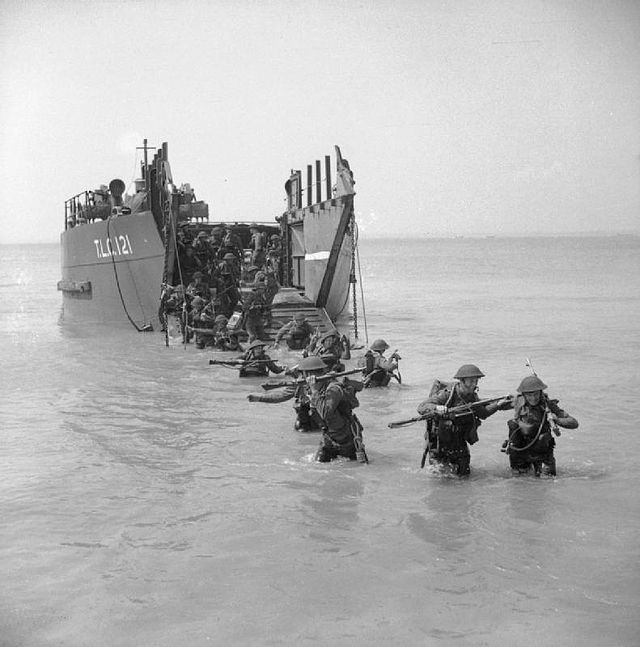 Pacific War Pacific WarMIDWAY OPERATIONS The Japanese Invasion Fleet sails from the Marianas toward Midway. A second invasion force heads for the Aleutians from Ominato. US aircraft carrier USS Yorktown arrives at Pearl Harbor, Hawaii, for repairs following the Battle of the Coral Sea on May 8 (repair estimates range between 2 weeks and 3 months). Admiral Frank Fletcher is surprised to learn that his Task Force 17 (with USS Yorktown) will leave for Midway Atoll in 2 days. Yorktown’s crew is dismayed not to get time to recover Stateside but repair work stats immediately. Japanese submarine I-25 launches its floatplane to reconnoiter US Navy's Naval Air Station Kodiak, on Kodiak Island near the mainland of Alaska, and spots a US cruiser and 2 destroyers. The intelligence is so important to their planned attack on the Aleutian Islands that another submarine I-26 lurks nearby to recover the floatplane, in case I-25 cannot. Japanese submarine I-19 dives while preparing to launch its floatplane off Bogoslof Island, in the Aleutian Islands, when lookouts think they spot a US destroyer (the aircraft is destroyed). WALLIS ISLANDS U.S. Marines and Navy Seabees occupy the Wallis Islands in the southwest Pacific Ocean in position 13.18S, 176.10W. CHINA-BURMA-INDIA (10th Air Force): 11th Bombardment Squadron, 7th BG (Heavy), transfers from Karachi to Lahabad, India with B-17's. SOUTHWEST PACIFIC AREA (5th Air Force): B-17's bomb Rabaul. 8th FG P-39s intercept Japanese fighters attacking Port Moresby. Lost is P-39F 41-7153 (MIA) and P-39F 41-7162 (pilot returned to duty). USN - The transfer of Patrol Wing 4 from Seattle to the North Pacific began with the arrival of the Commander at Kodiak. SAIPAN AND GUAM 5000 Japanese troops aboard 12 transports, escorted by cruiser Jintsu and 10 destroyers (commanded by Rear Admiral Raizo Tanaka), leave Saipan and Guam for the invasion of Midway Atoll. Japanese First Carrier Striking (4 aircraft carriers Akagi, Hiryū, Kaga and Sōryū, battleship Kirishima, cruisers Mikuma, Chikuma, Tone and Haruna and 12 other vessels under the command of Vice Admiral Chuichi Nagumo) leaves Japan in support of the invasion. SW PACIFIC TF 6814, on New Caledonia, is redesignated as the Americal Division. Comment on above: In today's report on "way back when" I noted, that on May 27, 1942 "TF 6814 became redesignated as the Americal Division." It was one of the few times in history that we were not known first as "the American Division", then since there was none such, "an American Division" which made us anonymous. We should all have joined the Marine Corps. HAWAII Photo: U.S. Navy Admiral Chester W. Nimitz presents awards on the flight deck of the aircraft carrier USS Enterprise (CV-6) moored at Pearl Harbor on 27 May 1942. One of those visible receiving a medal is Doris "Dorie" Miller, an African-American messman who was awarded the Navy Cross for his heroic actions on board the battleship USS West Virginia (BB-48) during the Pearl Harbor attack, which is visible in the background with salvage work going on. The bottom of USS Oklahoma (BB-37) is visible in front of West Virginia, the main mast of USS Arizona (BB-39) is beyond her Photo: The U.S. Navy aircraft carrier USS Yorktown (CV-5) arrives at Pearl Harbor after the Battle of Coral Sea on 27 May 1942, with her crew paraded in whites on the flight deck. The tug USS Hoga (YT-146) is in the center foreground. The mainmast of the sunken battleship USS Arizona (BB-39) is visible in the distance, just right of Yorktown´s stern. The carrier is wearing the standard Camouflage Measure 12 Photo: The U.S. Navy aircraft carrier USS Yorktown (CV-5) arrives at Pearl Harbor after the Battle of Coral Sea on 27 May 1942, with her crew paraded in whites on the flight deck. The tug USS Hoga (YT-146) is in the center foreground. The mainmast of the sunken battleship USS Arizona (BB-39) is visible in the distance, just right of Yorktown´s stern. The carrier is wearing the standard Camouflage Measure 12 Photo: The U.S. Navy heavy cruiser USS Vincennes (CA-44) at Pearl Harbor. A Curtiss SOC Seagull floatplane is in the left foreground Photo: The U.S. Navy heavy cruiser USS Vincennes (CA-44) at Pearl Harbor. A Curtiss SOC Seagull floatplane is in the left foreground
|
|
lordroel
Administrator
Member is Online
Posts: 68,107 
Likes: 49,494
|
Post by lordroel on May 28, 2021 6:39:05 GMT
Day 993 of World War II, May 28th 1942North African campaignLibya - Italian Ariete Division expects the fort at Bir Hacheim, defended by the Free French, to be a pushover. Having lost 32 tanks yesterday, Italians pause to consider their options. RAF bombers attack abandoned Italian tanks uncomfortably close to the fort, forcing the French out into no-man’s land to demolish them. In the Cauldron, Rommel’s attack runs out of steam in the face of British 1st and 7th Armoured Divisions. In addition, Italian Trieste Motorized Division has failed to find a way through the British minefields to bring up badly-needed supplies for the Panzers. However, Rommel's feint along the coast still dominates British General Ritchie’s thinking and he fails to grasp the opportunity to send his tanks en masse to annihilate Panzer Army Afrika. Photo: A German 20 mm anti-aircraft gun in the foreground and a Luftwaffe air raid on Bir Hakeim in the background Photo: Curtiss Kittyhawk Mark I, AK772 'GA-Y' "London Pride", of No. 112 Squadron RAF is prepared for a sortie at Gambut Main, Libya. The ground crew can just be seen assisting the pilot to strap himself into the cockpit. The aircraft is carrying a 250-lb GP Bomb, fitted with a surface-burst impact fuse, under the fuselage. Note also the plugs placed in the exhaust stubs to keep the desert sand out Photo: Curtiss Kittyhawk Mark I, AK772 'GA-Y' "London Pride", of No. 112 Squadron RAF is prepared for a sortie at Gambut Main, Libya. The ground crew can just be seen assisting the pilot to strap himself into the cockpit. The aircraft is carrying a 250-lb GP Bomb, fitted with a surface-burst impact fuse, under the fuselage. Note also the plugs placed in the exhaust stubs to keep the desert sand out Battle of the Caribbean Battle of the CaribbeanU-103 sinks US tanker SS New Jersey 90 miles Southwest of Grand Cayman Island (26 survivors picked up after 33 hours by US destroyer USS Tattnall, 15 survivors picked up by US destroyer USS Biddle on June 1) and U-502 sinks American SS Alcoa Pilgrim (31 killed, 9 survivors picked up 6 days later by American SS Thomas Nelson). Gulf of Mexico - U-106 sinks British SS Mentor (4 killed, 75 crew and 7 gunners picked up after 3 days by the British SS Antilochus). 150 miles East of Martinique, U-155 sinks Dutch SS Poseidon (all 32 hands lost). 525 miles East of Daytona Beach, Florida, U-506 sinks British SS Yorkmoor with 55 rounds from the deck gun, being out of torpedoes (all 45 hands in 2 lifeboats rescued on May 31 and June 4). Arctic naval operationsIn the Barents Sea, 3 Soviet destroyers and 4 minesweepers join convoy PQ-16 providing anti-aircraft firepower to drive off the Luftwaffe attacks. United StatesPhoto: The U.S. Navy destroyer USS McCalla (DD-488) underway on her delivery voyage from the Federal Shipbuilding and Dry Dock Company shipyard, at Kearny, New Jersey (USA), to the New York Naval Shipyard. Note the Federal SB & DD Co. flag flying just below her starboard yardarm Pacific War Pacific War MIDWAY OPERATIONS Japanese First Fleet, consisting of 7 battleships (Yamato, Mutsu, Nagato, Hyuga, Ise, Fuso and Yamashiro), light aircraft carrier Hosho, 3 cruisers, 21 destroyers and 4 oilers under the command of Admiral Isoroku Yamamoto, sails from Japan for Midway, 24 hours and 600 miles behind their carrier force. The Japanese have 2 aims at Midway. First, troops will occupy the island covered as usual by dive bombers from the carriers; second, dive and torpedo bombers will sink, damage and scatter US warships (especially US carriers) for final annihilation by the battleships. At 6.45 AM, US aircraft carrier USS Yorktown moves into Dry Dock No.1 at Pearl Harbor, Hawaii, for a second day of repairs following the Battle of the Coral Sea. Yorktown’s engines and aircraft elevators are operation but 1 bomb penetrated the flightdeck and caused much damage below while 2 near-misses had caused exterior damage to the hull. Only essential repairs to the flighdeck and structural elements are performed. Around noon, Admiral Spruance’s Task Force 16 (aircraft carriers USS Enterprise and USS Hornet, cruisers USS Atlanta, USS Minneapolis, USS New Orleans, USS Northampton, USS Pensacola and USS Vincennes, 9 destroyers and 4 oilers) leaves Pearl Harbor to intercept the Japanese carrier fleet heading to Midway. Photo: Yorktown in drydock at Pearl Harbor The Enterprise Air Group in USS Enterprise consists of Bombing Squadron Six with SBD Dauntless, Fighting Squadron Six with F4F Wildcats, Scouting Squadron Six with SBDs, and Torpedo Squadron Six with TBD Devastators. Photo: U.S. Navy Lieutenant Commander Eugene E. Lindsey's Douglas TBD-1 Devastator (BuNo 0370) sinking astern of the aircraft carrier USS Enterprise (CV-6) after a deck landing accident. The plane guard destroyer, USS Monaghan (DD-354) is in the left background. Enterprise was then en route to the Midway area. LCdr. Lindsey, Commanding Officer of Torpedo Squadron 6 (VT-6), was flying out with the rest of the air group to join the ship when the crash took place. He, and the other members of the plane's crew, were rescued by Monaghan The Hornet Air Group in USS Hornet consists of VB-8 with SBDs, VF-8 with F4Fs, VS-8 with SBDs and VT-8 with TBDs. ALASKA (11th Air Force): A B-17 flies the first armed reconnaissance from the secretly constructed airfield at Unmak , Aleutian over the Aleutian Chain, but finds no sign of the enemy. XI Fighter Command elements are not deployed at Unmak (P-40's and P-38's), Cold Bay (P-40's), Kodiak (P-39's), and Elmendorf Field [P-38's and Royal Canadian Air Force (RCAF) Kittyhawks]. UNITED STATES Secretary of War Henry L. Stimson warns Americans along the west coast to expect a Japanese attack as retaliation for the Dollittle raid on Tokyo. SOUTHWEST PACIFIC AREA (5th Air Force): B-26's attack the airfield at Lae, New Guinea. NEW HEBRIDIES U.S. forces arrive at Espiritu Santo. SOUTH CHINA SEA US submarine USS Salmon sinks Japanese passenger-cargo ship Ganges Maru in the South China Sea, 240 miles Southeast of Cam Ranh Bay, French Indochina.
|
|
lordroel
Administrator
Member is Online
Posts: 68,107 
Likes: 49,494
|
Post by lordroel on May 29, 2021 8:06:40 GMT
Day 994 of World War II, May 29th 1942Eastern Front Battle of Kharkov ends with 25,000 Soviet troops killed and another 240,000 taken prisoner by the Germans. Red Army has lost most of 22 rifle divisions, 7 cavalry divisions and 15 tank brigades (540 aircraft, 1200 tanks and 2000 field guns and artillery pieces destroyed or captured). 25,000 Soviet stragglers reach safety in their own lines. German losses are 20,000 dead, wounded and missing. Photo: Captured Soviets marching through Kharkov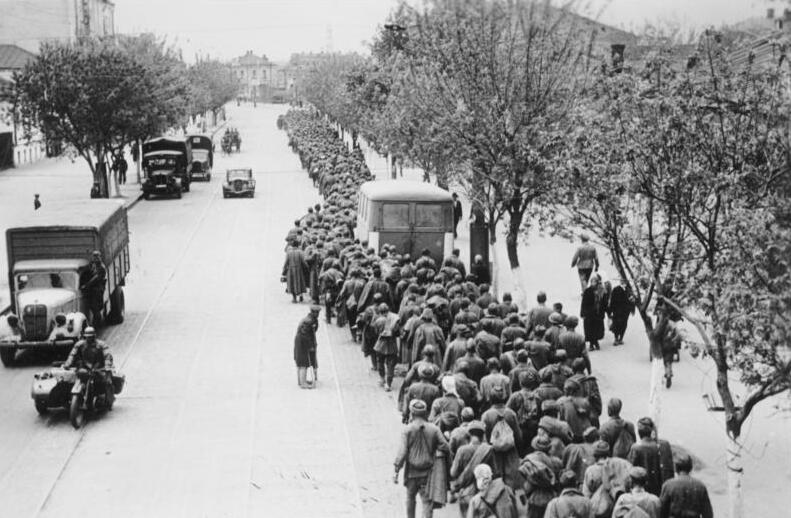 Air War over Europe Air War over Europe Overnight, RAF sends 77 aircraft (31 Wellingtons, 20 Halifaxes, 14 Lancasters, 9 Stirlings, 3 Hampdens) to bomb the Gnome & Rhone factory at Paris/Gennevilliers, France. There is little damage to the factory, but 38 houses are destroyed with 34 French civilians killed and 167 injured. 4 Wellingtons and 1 Halifax are lost. Luftwaffe bombers attack Grimsby, England. During conferences with RAF Air Chief Marshall Sir Charles F Portal, Lieutenant General Henry H "Hap" Arnold, Commanding General USAAF, presents "Programme of Arrival of US Army Air Forces in the United Kingdom" providing for 66 combat groups, exclusive of observation squadrons, by March 1943. Black Sea campaign Soviet submarine A-3 sinks Romanian vessel Sulina and Soviet submarine SC-214 sinks Turkish vessel Hudarvendigar. Battle of the Caribbean60 miles west of St. Lucia, U-156 sinks British SS Norman Prince (16 killed; 32 survivors picked up by French merchant Angouleme, landed at Martinique and interned by Vichy French; radio officer Hubert John Tanner rescued after 2 days by US Coast Guard cutter USS Unalga). At 2.17 AM 10 miles off Rio Seco, Cuba, U-107 sinks British SS Western Head (24 crew lost, 6 survivors picked up by a US Navy patrol ship and landed at Guantanamo Bay). At 11.37 PM 54 miles South of Grand Cayman Island, U-50 sinks British SS Allister (15 crew lost, 8 survivors land at Port au Prince, Haiti). Battle of the Mediterranean40 miles Northeast of Tobruk, U-568 is forced to the surface and then scuttled by her crew, after 16 hours of depth charging by British destroyers HMS Hero, HMS Eridge and HMS Hurworth (all 47 hands survive). At 7 AM 135 miles Northwest of Benghazi, British submarine HMS Turbulent fires 4 torpedoes at 2 Italian merchant vessels escorted by 2 destroyers. 1 torpedo sinks Italian merchant Capo Arma while another torpedo runs in a circle over the top of the submarine and “with a great deal of luck” sinks Italian destroyer Emmanuele Pessagno. North African campaignLibya - In the morning, Italian Trieste Division finds a way through the British minefields to bring up supplies, despite heavy shelling from the British “boxes”. British General Ritchie is still slow in organizing an attack on the trapped Panzers with his greater number of tanks. In the Cauldron, Rommel pulls back to a series of ridges and hollows just East of the minefields which now serve to protect his flank. He uses a dense sandstorm to dig in anti-tank guns on the Sidra and Azlagh Ridges as a trap for the British armour. Afrika Korps commander General Ludwig Crüwell, leading the attack along the coast, is flying over the front line when he strays over British 150th Brigade “box” and his Storch light aircraft is shot down. The pilot is killed by the gunfire, the Storch crash lands and Crüwell is captured. Photo: The Free French forces in the western desert of Africa, although not very large in numbers, are doing most valuable work. They have their own famous 75 mm. guns, maintain patrols with armored vehicles, and are manning outposts in some of the most forward areas United StatesPhoto: The U.S. Navy destroyer USS Barton (DD-599) in Boston Harbor, Massachusetts (USA), on 29 May 1942 United StatesPhoto: The U.S. Navy destroyer USS Barton (DD-599) in Boston Harbor, Massachusetts (USA), on 29 May 1942 Photo: USS Quincy (CA-39) - view taken at New York Navy Yard, NY, 29 May, 1942, looking forward from fantail, on centerline. Note covered .50 cal AA/MG (L&R), 1.1" guns. USS Marblehead (CL-12) in left background. USS Juneau (CL-52) in background (right) Photo: USS Quincy (CA-39) - view taken at New York Navy Yard, NY, 29 May, 1942, looking forward from fantail, on centerline. Note covered .50 cal AA/MG (L&R), 1.1" guns. USS Marblehead (CL-12) in left background. USS Juneau (CL-52) in background (right) Photo: USS Quincy (CA-39) - view taken 29 May, 1942, at New York Navy Yard, NY looking aft from bow. Numbers and arrows denote modifications. Note USS Juneau (CL-52) in background (l) & USS Marblehead (CL-12) in background (r) Photo: USS Quincy (CA-39) - view taken 29 May, 1942, at New York Navy Yard, NY looking aft from bow. Numbers and arrows denote modifications. Note USS Juneau (CL-52) in background (l) & USS Marblehead (CL-12) in background (r) PanamaPhoto: Curtiss P-40C Warhawk, 29th Fighter Squadron May 1942, Madden Field, Panama PanamaPhoto: Curtiss P-40C Warhawk, 29th Fighter Squadron May 1942, Madden Field, Panama Pacific War Pacific WarMIDWAY OPERATIONS At French Frigate Shoals, Territory of Hawaii, the seaplane tender (destroyer) USS Thornton (AVD-11) arrives to relieve the light minelayer USS Preble. Later that day, the Japanese submarine I-123 also arrives. The Japanese had intended to use the shoals as a refueling stop for Japanese seaplanes flying reconnaissance missions over Pearl Harbor; the aircraft would be refueled by submarines. The presence of the U.S. ships prevents this operation and the Japanese never learn that two of the USN's aircraft carriers have already departed Pearl Harbor. The seaplane tender (destroyer) USS Ballard (AVD-10) arrives at Midway with eleven motor torpedo boats (PTs) of Motor Torpedo Squadron One (MTBRon 1). AUSTRALIA The Japanese submarine I-21 launches a "Glen," to fly a reconnaissance mission over Sydney, Australia. SOLOMONS The USN's Patrol Squadron Seventy One based at Noumea, New Caledonia on the seaplane tenders USS Curtiss and USS Tanigier with PBY-5 Catalinas joins RAAF Catalinas in bombing Tulagi Island in the Solomon Islands. MADAGASCAR Diego Suarez: About ten miles from the harbour entrance, the Captains of the Japanese submarines I-16, I-18 and I-20 were ordered to launch their Type "A" midget submarines. I-18's midget took no part in the attack because the launching machinery failed to work properly. The I-18 Mother submarine with its midget still on board was therefore forced to return to the armed flotilla support ships Hokoku Maru, 10,438 tons and the Airoko Maru, 10,437 tons, for maintenance. The other two midgets were successfully launched and started their mission. CHINA-BURMA-INDIA (10th Air Force): 4 B-17's hit Myitkyina Airfield, Burma in a high-altitude strike. No activity is seen. HAWAII (7th Air Force): 19th Transport Squadron, 7th Air Force, transfers from Hickam Field to John Rodgers Airport, Territory of Hawaii with C-33's and C-53's. An army of fitters, machinists and welders labours all night at Pearl Harbor, Hawaii, on US aircraft carrier USS Yorktown and, in the morning, she is refloated after only 1 day in drydock. Repairs continue as USS Yorktown is refueled and receives a new complement of aircraft and aircrews from Kaneohe Nava Air Station. NEW GUINEA Tainan Kokutai Zeros are intercepted SE of Port Moresby in the vicinity of Hood Bay at 0950 hours. Eighteen Zeros encountered 17 Airacobras. The US claimed three at the time but were later credited with four. Lost was Zero piloted by P/O 2nd Class Hisao Komori, that crashed near Iwaia (Oro Province). Came down at 1000 Hrs. The pilot was trailed and fired three shots but was killed resisting arrest. Pilot was carrying a map showing operations of (medium?) planes from an island (Truk). Lost is P-39F 41-7116 AUSTRALIA Japanese submarine I-21 launches its floatplane to reconnoiter Sydney, Australia. INDIAN OCEAN Photo: Fairey Albacores of No 820 Squadron Fleet Air Arm from HMS Formidable (R67) in the Indian Ocean. One of the aircraft has just flown off the aircraft carrier whilst two more can be seen on deck (photographed from HMS Warspite) BALABAC STRAIT In the Balabac Strait between Borneo and the Philippines, US submarine USS Swordfish sinks Japanese transport ship Tatsufuku Maru, which was damaged by torpedoes from USS Seal yesterday.
|
|
lordroel
Administrator
Member is Online
Posts: 68,107 
Likes: 49,494
|
Post by lordroel on May 30, 2021 2:42:58 GMT
Day 995 of World War II, May 30th 1942YouTube (Rommel's Desert Dash - The Whole Bloody Afrika Korps! - Gazala)Battle of the AtlanticDespite continued Luftwaffe attacks, 21 ships from convoy PQ16 arrive at Murmansk, USSR (another 8 ships go to Archangelsk, arriving June 1). Photo: The U.S. Navy small seaplane tender USS Barnegat (AVP-10) in Hvalfjörður, Iceland, circa 29 May to 2 June 1942 after covering Russian convoys. She is painted in Camouflage Measure 12 (Modified) Air War over Europe - Operation MILLENNIUM Air War over Europe - Operation MILLENNIUMOvernight, RAF sends 1,047 aircraft (602 Wellingtons, 131 Halifaxes, 88 Stirlings, 79 Hampdens, 73 Lancasters, 46 Manchesters & 28 Whitleys) to attack Cologne, Germany, in the first 1,000 bomber raid (Operation Millennium). The goal is to overwhelm German night fighter and anti-aircraft defenses with sheer numbers. 868 bombers reach the target dropping 1,455 tons of explosives (2/3 incendiaries). 250 factories and 18,400 houses are destroyed or damaged mainly by fire (411 German civilians and 58 anti-aircraft gunners killed, 5,027 injured and 45,132 lose their homes). 41 RAF aircraft are lost. Photo: vertical aerial photograph taken during Operation MILLENNIUM, the 'Thousand-bomber' raid on Cologne, Germany 30/31 May 1942. The tracks of a mass of concentrated searchlights and tracer bullets from anti-aircraft fire cover the larger area of the picture as the first bombs explode on the city (lower left) Photo: Vertical photographic-reconnaissance aerial taken over Cologne, Germany after Operation MILLENNIUM, the first 'Thousand-bomber' raid by aircraft of Bomber Command on the night of 30/31 May 1942. This shows the partially-destroyed exhibition hall (Osthalle) and railway sidings in Koln-Deutz Photo: Vertical photographic-reconnaissance aerial taken over Cologne, Germany after Operation MILLENNIUM, the first 'Thousand-bomber' raid by aircraft of Bomber Command on the night of 30/31 May 1942. This shows the partially-destroyed exhibition hall (Osthalle) and railway sidings in Koln-Deutz Photo: Members of No. 106 Squadron RAF, including their Commanding Officer, Wing Commander Guy Gibson (standing middle, front row), celebrate on their return to Coningsby, Lincolnshire, from the 'Thousand Bomber' raid on Cologne, Germany. The Squadron's Avro Manchesters, in the course of replacement by Lancasters at this time, are parked off the perimeter track in the background Photo: Members of No. 106 Squadron RAF, including their Commanding Officer, Wing Commander Guy Gibson (standing middle, front row), celebrate on their return to Coningsby, Lincolnshire, from the 'Thousand Bomber' raid on Cologne, Germany. The Squadron's Avro Manchesters, in the course of replacement by Lancasters at this time, are parked off the perimeter track in the background Battle of the Mediterranean Battle of the Mediterranean70 miles West of Bengasi, Libya, British submarine HMS Proteus sinks the Italian merchant Bravo. Battle of the Caribbean500 miles East of Barbados, U-155 sinks Norwegian MV Baghdad (9 dead, 21 survivors). At 10.24 AM 500 miles East of Cape Charles, Virginia, U-404 sinks US freighter SS Alcoa Shipper carrying 8340 tons of bauxite ore (7 killed 25 survivors on 3 rafts are questioned by the Germans and given several bottles of rum, cigarettes and a dungarees for a man with little clothing, then rescued 56 hours later by Norwegian steamer Margrethe Bakke). United States Photo: USS Amberjack (SS-219) off Groton, Connecticut, 30 May 1942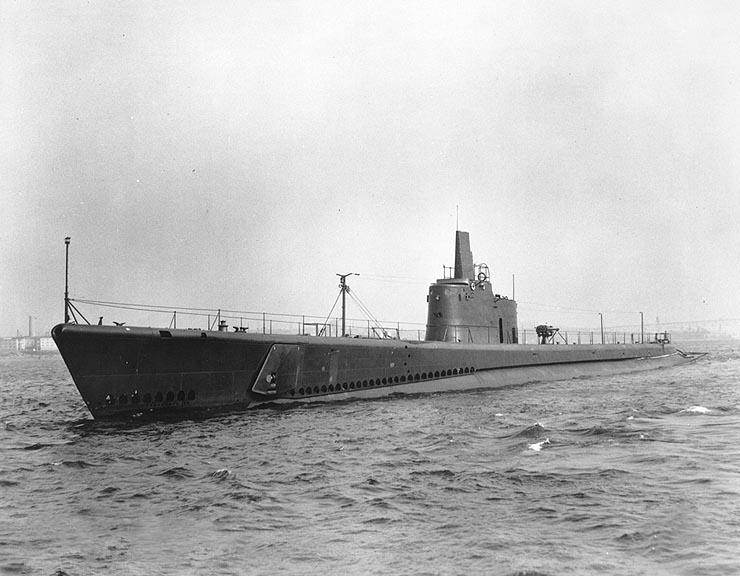 Pacific War Pacific War MADAGASCAR Japanese submarine I-10 launches its floatplane over the harbor at Diego Suarez, Madagascar, spotting British battleship HMS Ramillies plus a tanker, a freighter and an ammunition ship. At 5.40 PM, I-16 and I-20 send midget submarines M-16b and M-20b into the harbor from 10 miles offshore (I-18’s midget M-18b cannot launch due to engine trouble). At 8.25, M-20b fires a 17.7-inch torpedo into HMS Ramillies, opening a 30-foot hole near the forward turret (15-inch guns) and flooding magazines and shell rooms (HMS Ramillies will be towed to Durban, South Africa, for temporary repairs, then sail to Plymouth, England, in August under her own steam and return to service in June 1943). At 9.20 PM, as corvettes HMS Genista and HMS Thyme drop depth charges, M-20b fires the 2nd torpedo and sinks British tanker British Loyalty. The 2-man crew of M-20b escape but are killed by Royal Marines 3 days later. Illustration: attack on HMS Ramillies ALEUTIAN ISLANDS Japanese submarine I-25 prepares to launch her floatplane to reconnoiter Dutch Harbor Naval Operating Base and Fort Mears, on Unalaska Island in the Aleutian Islands, when lookouts spot an American cruiser. I-25 cannot dive with her plane on deck, but the cruiser passes by without noticing her. MIDWAY OPERATIONS U.S. Navy Task Force 17, consisting of the aircraft carrier USS Yorktown (CV-5), departs Pearl Harbor to join Task Force 16 northeast of Midway Island. The Yorktown Air Group consists of Bombing Squadron Three (VB-3) with Douglas SBD Dauntlesses, VB-5 with SBDs, Fighting Squadron Three (VF-3) with Grumman F4F Wildcats, and Torpedo Squadron Three (VT-3) with Douglas TBD Devastators. The 7th Air Force in the Territory of Hawaii dispatches six B-17's to Midway Island to reinforce the fifteen that are already there. A Japanese task force consisting of two light aircraft carriers and two troop transports departs northern Honshu Island for the Aleutian Islands. ALASKA (11th Air Force): 77th Bombardment Squadron (Medium), 28th Composite Group, based at Elmendorf Field, Anchorage, Territory of Alaska, begins operating from Umnak, Aleutian with B-26's. CHINA-BURMA-INDIA (10th Air Force): Myitkyina, Burma is again hit by B-17's. Again no activity is observed and the attacks are discontinued. HQ 7th Bombardment Group transfers from Karachi to Dum-Dum, India. PACIFIC OCEAN AREA (7th Air Force): 7th Air Force begins flying B-17's from the Territory of Hawaii to Midway in the face of an expected attack on that. 394th Bombardment Squadron, 5th BG (Heavy), transfers from Hickam Field to Bellows Field, Territory of Hawaii with B-17's. HAWAII Photo: The U.S. Navy destroyer USS Phelps (DD-360) at Pearl Harbor, Territory of Hawaii, circa in late May 1942, following the Battle of Coral Sea and shortly before the Battle of Midway. Note that her heavy tripod masts and the reserve torpedoes were removed
|
|
lordroel
Administrator
Member is Online
Posts: 68,107 
Likes: 49,494
|
Post by lordroel on May 31, 2021 2:48:16 GMT
Day 996 of World War II, May 31st 1942Battle of the Atlantic25 miles West of Nova Scotia, U-432 sinks Canadian SS Liverpool Packet (2 dead and 19 survivors reach nearby Seal Island). At 2.52 AM 200 miles southeast of Bermuda, U-506, which is out of torpedoes, sinks British SS Fred W Green with 34 rounds from the deck gun (5 killed, 36 survivors including 6 wounded in 2 lifeboats rescued next day by US destroyer USS Ludlow). In the South Atlantic 500 miles Northwest of Natal, Brazil, British Royal Fleet Auxilliary tanker RFA Dinsdale is sunk, on her maiden voyage, by Italian submarine Comandante Cappellini with 4 of 6 torpedoes fired (5 killed). Battle of the MediterraneanGeneral Kesselring gave his plan for an invasion of Malta to the Italian Commando Supremo. Air War over EuropeLuftwaffe bombs Canterbury in Southeast England, in retaliation for the bombing of Cologne last night. North African campaignLibya - 90 miles West of Bengazi, British submarine HMS Proteus sinks Italian merchant ship Gino Allegri. At Bir Hakeim fort, the water supply is critically low (Rommel had ‘released’ 620 thirsty Indian POWs captured from 3rd Indian Motor Brigade on May 26 and sent them to the fort); however, 50 trucks (101st motorized company) arrive with water and then evacuate the Indians, Italian prisoners and the wounded. With Rommel “trapped” in the Cauldron, British General Ritchie writes to his superior General Auchinleck “Now I’ve got him in the hollow of my hand”. But it is Rommel who attacks, coming West out of the Cauldron with large numbers of tanks to assail the British 150th Brigade “box” where battle rages all night. Photo: General Ritchie (holding pipe) addressing his commanders, 31 May 1942. Norrie holding map, Gott to right of Ritchie Photo: Grant tanks and scout cars of an armoured brigade headquarters in the Western Desert, 31 May 1942 Photo: Grant tanks and scout cars of an armoured brigade headquarters in the Western Desert, 31 May 1942 Photo: A truck mounted 6-pdr anti-tank gun in the Western Desert, 31 May 1942 Photo: A truck mounted 6-pdr anti-tank gun in the Western Desert, 31 May 1942 Black Sea campaign Black Sea campaign Soviet submarine SC-214 sinks Turkish vessel Mahbubdihan which is suspected of running supplies to German troops. Pacific WarMADAGASCAR Japanese submarine I-10 launches its floatplane to survey the damage from last night’s midget submarine attack on Diego Suarez harbor, Madagascar. AUSTRALIA - ATTACK ON SYDNEY HARBOUR 5 large Japanese I Class submarines rendezvoused some 35 nautical miles northeast of the entrance to Sydney Harbour. Before daylight the next morning an E14Y Glen float plane launched from one of the submarines, I-21, and crewed by Warrant Flying officer Susumo Ito and Ordinary Seaman Iwasaki, flew a daring reconnaissance mission over the harbour, twice circling the cruiser USS Chicago before flying off to the east. The aerial intrusion was observed and reported but it did not initiate any special harbour defensive measures being implemented. Many mistakenly believed it an American floatplane conducting a routine training flight. For the Japanese raiders, it was the latest of a number of reconnaissance flights conducted over Sydney providing valuable intelligence for an impending surprise attack on the numerous Allied warships anchored peacefully in the harbour. Prime targets included the cruisers HMAS Canberra and USS Chicago. Photo: USS Chicago in Sydney Harbour at the time of the attack by Japanese submarines. Note the aerial for early air search radar, type exam, on the mainmast
 The first midget submarine to enter Sydney Harbour, M-27 manned by Lieutenant Kenshi Chuman and Petty Officer Takeshi Omori, did so at approximately 8:00pm. It had not gone far, however, when the vessel’s propellers became entangled in anti-submarine nets close to the western boom gate. The disturbance in the water caused by the snared submarine was soon observed and subsequently reported at which time the patrol boats HMAS Yarroma and HMAS Lolita were ordered to investigate. They were cheated of their prey, however, when the submarine’s crew, realizing that they could not free the midget’s propellers, chose a warrior’s death, firing demolition charges that destroyed their craft at 10:37pm and raising a general alarm. The second midget submarine, M-24, crewed by Sub Lieutenant Katsuhisa Ban and Petty Officer Mamoru Ashibe, successfully entered the harbour at 9:48pm. Some time later Chicago, lying at the Man-of-War anchorage, sighted the midget’s periscope about 500 yards distant. Searchlights were quickly illuminated and shots were fired in its general direction. However, Chicago’s guns could not be depressed sufficiently and her gunfire had no discernible effect. Half an hour later, Sub Lieutenant Ban fired two torpedoes at Chicago both of which missed the intended target. One ran ashore at Garden Island failing to explode, while the second passed under the Dutch submarine K9 striking the sea wall on Garden Island. It exploded on impact beneath the requisitioned Sydney Harbour ferry Kuttabul, which at that time was being used as an RAN depot ship. Kuttabul sank immediately and 21 Allied naval ratings, 19 Australian and two British were killed. Photo: HMAS Kuttabul following the Japanese attack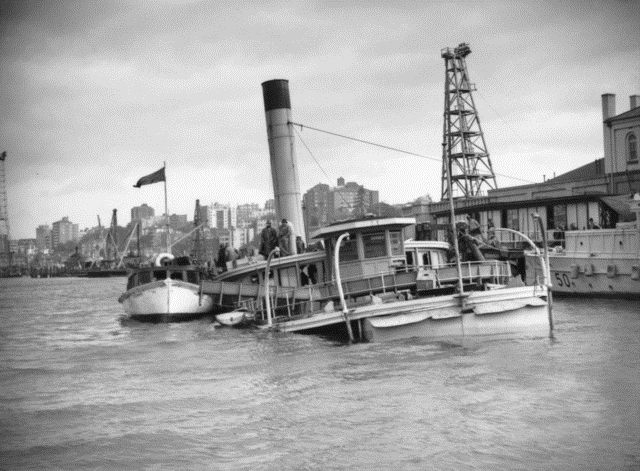 Photo: HMAS Kuttabul following the Japanese attack Photo: HMAS Kuttabul following the Japanese attack Although the harbour was alive with activity following the attack on Chicago, confusion reigned with some believing the gunfire to be part of a naval exercise as ships began to weigh anchor and proceed to sea. Later in the early hours of 1 June a third enemy midget submarine, M-22, crewed by Lieutenant Kieu Matsuo and Petty Officer 1st Class Masao Tsuzuku, entered the harbour. It was later detected in Taylors Bay where it was depth charged repeatedly by the patrol boats Sea Mist, Steady Hour and Yarroma. Map: The tracks of the three midget submarines through Sydney Harbour The following day RAN divers were sent to investigate the crippled vessel, finding its engines still running and its contra-rotating propellers slowly turning. It was subsequently raised and its two man crew found dead inside from self inflicted gunshot wounds. Photo: The Japanese Ko-hyoteki class midget submarine, believed to be midget M-22, crewed by Lieutenant Kieu Matsuo and Petty Officer 1st Class Masao Tsuzuku is raised from Sydney Harbour the day after the attack
 MIDWAY ATOLL Photo: U.S. Army Air Force Boeing B-17E Flying Fortress bombers of the 431st Bombardement Squadron take off from the airfield on Eastern Island, Midway Atoll, on the afternoon of 31 May 1942. The plane in the center is an early-model B-17E-BO (s/n 41-2397), with a Bendix remotely controlled belly turret, flown by 1st Lt. Kinney
|
|
lordroel
Administrator
Member is Online
Posts: 68,107 
Likes: 49,494
|
Post by lordroel on Jun 1, 2021 2:53:15 GMT
Day 997 of World War II, June 1st 1942Eastern FrontThe seige of the Crimean fortress of Sevastopol by 11. Armee (von Manstein) continued with a round-the-clock bombardment by heavy artillery and Luftwaffe bombers. Photo: German 11th Army soldiers approach burning Sevastopol in June 1942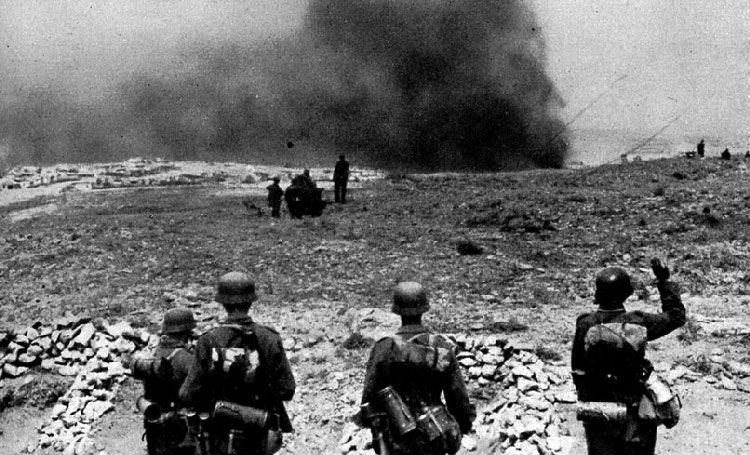 Photo: Luftwaffe aerial reconnaissance photo of the battleship Sovetsky Soyuz and a Chapaev-class cruiser under construction in the Baltic Shipyard Photo: Luftwaffe aerial reconnaissance photo of the battleship Sovetsky Soyuz and a Chapaev-class cruiser under construction in the Baltic Shipyard Photo: Luftwaffe aerial reconnaissance photo of the sunken battleship Marat in Kronstadt harbor Photo: Luftwaffe aerial reconnaissance photo of the sunken battleship Marat in Kronstadt harbor Air War over Europe Newspaper: Daily Express and the New York Times editions, June 1st 1942 Air War over Europe Newspaper: Daily Express and the New York Times editions, June 1st 1942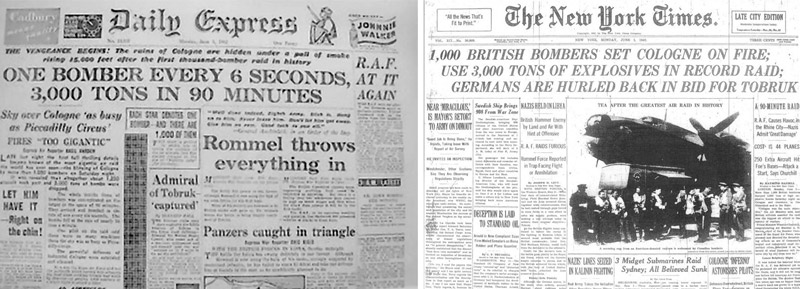 Battle of the Atlantic Battle of the Atlantic 8 merchant ships from convoy PQ-16 arrive at Archangelsk, USSR. German Ju-88 bombers attack the unloading freighters, sinking the SS Steel Worker and damaging Soviet submarine SC-404. In the Atlantic 320 miles East of Cape Hatteras, North Carolina, U-404 sinks American SS West Notus with gunfire (4 dead, 36 survivors). Another 360 miles East, U-566 sinks British SS Westmoreland (3 dead, 65 survivors). North African campaignGerman and Italian troops and tanks, with Rommel personally taking charge, break through the British perimeter and overrun 150th Brigade “box” at Sidi Muftah in bitter hand-to-hand fighting. A relief column sent by the British along the Trigh Capuzzo and Trigh el Abd desert tracks is stopped by Rommel's anti-tank screen. 3000 British troops surrender, after their commander Brigadier Clive Haydon is killed by shellfire. This allows Rommel to secure supply lines North and South of the British who have been harrying his trucks with artillery fire. Capture of this “box” also completes the encirclement of the French in the fort at Bir Hacheim. Photo: The commander of a Stuart tank uses a knocked-out PzKpfw III tank as cover while observing the enemy, 1 June 1942 Photo: A knocked-out German PzKpfw III tank being searched by infantry 1 June 1942 Photo: A knocked-out German PzKpfw III tank being searched by infantry 1 June 1942 Photo: Generalleutnant Ludwig Crüwell seen on the right, became commander of the Afrika Korps on 31 July 1941, under General Erwin Rommel who on the same day took command of Panzer Army Africa, Crüwell was inspecting operations by air in Libya. His pilot mistook British troops for Italian soldiers and landed, where Crüwell was taken prisoner, here he can be seen dining with British officers, 1 June 1942 Photo: Generalleutnant Ludwig Crüwell seen on the right, became commander of the Afrika Korps on 31 July 1941, under General Erwin Rommel who on the same day took command of Panzer Army Africa, Crüwell was inspecting operations by air in Libya. His pilot mistook British troops for Italian soldiers and landed, where Crüwell was taken prisoner, here he can be seen dining with British officers, 1 June 1942 Battle of the Caribbean Battle of the CaribbeanOff the Western end of Cuba, U-107 sinks Panamanian SS Bushranger at 3.54 AM (17 killed, 7 survivors on a raft picked up by a US Navy Catalina aircraft on June 7, another 19 survivors on 3 rafts that stayed together rescued by US Coast Guard cutter USS Nike on June 12). U-106 sinks American SS Hampton Roads at 11.40 AM (7 killed, 23 survivors picked up by American SS Alcoa Pathfinder). At 11.51 PM between St. Lucia and St. Vincent, U-156 sinks neutral Brazilian SS Alegrete (all 64 hands escape in 4 lifeboats). Air War over EuropeOvernight, 956 RAF bombers attack Essen, Germany (545 Wellingtons, 127 Halifaxes, 77 Stirlings, 74 Lancasters, 71 Hampdens, 33 Manchesters and 29 Whitleys). Due to low cloud, bombing is very inaccurate and towns are hit all over the Ruhr valley. 15 Wellingtons, 8 Halifaxes, 4 Lancasters, 1 Hampden, 1 Manchester, 1 Stirling, 1 Whitley are lost. Photo: A view from the cockpit of an Avro Lancaster, believed to be an aircraft of No 207 Squadron, Royal Air Force, as work is done on the starboard Merlin engines of the aircraft, near the technical site at Bottesford United StatesPhoto: The U.S. Navy light cruiser USS Juneau (CL-52) off New York City (USA), 1 June 1942. A barge is alongside her starboard quarter. Her superstructure retains its original measure 12 "mottled pattern" camouflage scheme, but her hull has been repainted wave-style pattern United StatesPhoto: The U.S. Navy light cruiser USS Juneau (CL-52) off New York City (USA), 1 June 1942. A barge is alongside her starboard quarter. Her superstructure retains its original measure 12 "mottled pattern" camouflage scheme, but her hull has been repainted wave-style pattern Pacific War Pacific War UNITED STATES, SAN DIEGO USS Saratoga sails from San Diego after repair of the torpedo damage that occurred January 11, 1942. MIDWAY OPERATIONS In the U.S., fear of an attack on the west coast causes suspension of the movement of USAAF aircraft and crews from the U.S. to the U.K. 25 US subs are in position off Midway Island. At 1300 hours local, the Japanese Kiska Invasion Force departs Kashiwabara on Paramushiru Island in the Kurile Islands enroute to Kiska Island in the Aleutians. The U.S. Navy's Task Group 8.6 built around the light cruiser USS Nashville (CL-43) enters the Gulf of Alaska intending to position themselves about 400 miles (741 km) south of Kodiak Island to "exploit opportunities. " Unfortunately, they will be too far away for the upcoming action. ALASKA In Alaska, the USAAF's 11th Air Force has a B-17E Flying Fortress, six B-26 Marauders and 17 P-40s at Cold Bay on the tip of the Alaskan Peninsula and 12 P-40s, six B-26 and a B-17E at Otter Point on Umnak Island. During June 1942, 11th Fighter Squadron, 28th Composite Group, moves from Elmendorf Field, Anchorage to Ft Glenn, Umnak with P-40s. During Jun, 406th Bombardment Squadron (Medium), 41st Bombardment Group (Medium), sends detachments to operate in Alaska with B-18s. INDIAN OCEAN For the third straight day, the Japanese submarine I-10 launches a "Glen," to fly a reconnaissance mission over Diego Suarez, Madagascar. CHINA-BURMA-INDIA THEATER OF OPERATIONS (10th Air Force): 5 heavy bombers attack the Rangoon, Burma dock and harbor area, claiming 1 tanker sunk and another left listing. 436th Bombardment Squadron (Heavy), 7th Bombardment Group (Heavy), moves from Karachi to Lahabad, India with B-17Es; first mission is 4 Jun. SOUTHWEST PACIFIC AREA (5th Air Force): B-17s attack Lae and Salamaua and Rabaul.
|
|
lordroel
Administrator
Member is Online
Posts: 68,107 
Likes: 49,494
|
Post by lordroel on Jun 2, 2021 2:49:57 GMT
Day 998 of World War II, June 2nd 1942Eastern FrontLuftwaffe bombers return to the Crimean peninsula to open a renewed campaign to capture the massive Soviet port of Sevastopol, home of the Black Sea Fleet, following their crushing of the Soviet offensive at Kharkov. Under Luftwaffe General Wolfram Freiherr von Richthofen, they fly 723 missions and drop 525 tons of high explosive targeting submarine bases, oil storage, electricity, water pumps, and harbour facilities. Despite heavy anti-aircraft fire, only 1 Ju87 dive bomber is lost. Air War over Europe Overnight, RAF send 195 bombers (97 Wellingtons, 38 Halifaxes, 27 Lancasters, 21 Stirlings, 12 Hampdens) back to Essen, Germany, but the raid is no more accurate than last night (only 3 high-explosive bombs and 300 incendiary canisters hit the city, with no serious damage or casualties). 7 Wellingtons, 2 Halifaxes, 2 Lancasters, 2 Stirlings and 1 Hampden are lost. Luftwaffe bombs Canterbury, England, in retaliation for the bombing of Essen yesterday. The air echelons of the four squadrons of the USAAF's 97th Bombardment Group (Heavy), equipped with B-17Es and preparing to deploy to the U.K, are ordered to bases on the U.S. west coast as a defensive measure against Japanese attack. Battle of the Atlantic South of Freetown, Sierra Leone, Italian submarine Leonardo da Vinci sinks Panamanian schooner Reine Marie Stewart. Off the Northeast coast of USA, U-553 sinks British MV Mattawin at 7.18 AM (all crew, gunners and passengers survive) and Norwegian MV Berganger is missed by 5 torpedoes from U-213 between 3.32 and 7.05 AM but then sunk at 8.27 PM by U-578 southeast of Cape Cod (4 dead, 43 survivors). Battle of the Caribbean450 miles Southeast of Bermuda, U-159 torpedoes American SS Illinois at 2.53 AM, which sinks immediately on her cargo of 8000 tons of manganese ore (32 dead, 6 survivors picked up 6 days later by American tanker SS Esso Montpelier) and U-558 sinks Dutch SS Triton with the deck gun at 2.55 AM (6 killed, 29 crew and 1 passenger picked up after 3 days by American SS Mormacport). Off the Western end of Cuba, U-158 sinks American SS Knoxville City at 2.57 AM (2 killed, 37 crewmen, 14 gunners and 4 passengers abandon ship in 2 lifeboats and reach Cuba). North African campaignIn Libya, Rommel is growing desperately short of food, water, fuel and ammunition; his offensive is threatening to stall out. After conquering British 150th Brigade, he sends German 90th Light Division and Italian Trieste Division to attack Free French troops at Bir Hacheim, who have been preventing supply convoys getting through South of the British minefields. 12 miles Northeast of Bardia, U-652 is depth charged by British Martin 187 Baltimore aircraft (RAF 203 Squadron) and Swordfish torpedo bombers (815 Naval Air Squadron). U-652 is severely damage and abandoned (all 46 hands rescued by U-81 which scuttles U-652). Photo: British 25 pounder guns fire at Erwin Rommel's Afrika Korps on the night of 2 June 1942 during the battle of Gazala, Libya United States Photo: a Petlyakov Pe-8 at Bolling Field, June 1942. It brought Soviet Foreign Minister Molotov to the United States. Note Douglas A-20 in the background United States Photo: a Petlyakov Pe-8 at Bolling Field, June 1942. It brought Soviet Foreign Minister Molotov to the United States. Note Douglas A-20 in the background Photo: a Petlyakov Pe-8 being serviced at Bolling Field. It had brought Soviet foreign minister Molotov to the United States. Note Russian and USAAF personnel working on the plane, and various servicing stands and ladders Photo: a Petlyakov Pe-8 being serviced at Bolling Field. It had brought Soviet foreign minister Molotov to the United States. Note Russian and USAAF personnel working on the plane, and various servicing stands and ladders United KingdomPhoto: Admiral Aboyneau and party on board the Free French ship Ouragan at Portsmouth United KingdomPhoto: Admiral Aboyneau and party on board the Free French ship Ouragan at Portsmouth Pacific War Pacific War PACIFIC OCEAN AREA (7th Air Force): 6 of 16 B-17s that have been on detached service at Midway return to Oahu, Territory of Hawaii. SOUTHWEST PACIFIC AREA (5th Air Force): B-17s bomb the dock and military camp area at Rabaul. 39th Fighter Squadron, 35th Fighter Group, moves from Woodstock, Australia to Port Moresby, New Guinea with P-39s; first mission is today. AUSTRALIA Australian Prime Minister John Curtin bouyed by the arrival of American forces challenges the Japanese, saying "I defy the enemy to land large forces in Australia". MIDWAY OPERATION US Carrier TF meet NE of Midway Island. Amplifying the above, Task Force 17 (TF-17) under Rear Admiral Frank Jack Fletcher and TF-16 under Rear Admiral Raymond A. Spruance, rendezvous about 350-miles (648 km) northeast of Midway Island. The joint force, under tactical command of Admiral Fletcher, is composed of three aircraft carriers, seven heavy cruisers, one light cruiser, 16 destroyers and two oilers. Supporting are 25 submarines deployed around Midway. Six of the 16 B-17E Flying Fortresses that have been on detached service at Midway Island return to Oahu, Territory of Hawaii. Two PBY-5A Catalinas of the USN's Patrol Squadron Forty One (VP-41) based at Naval Air Station Dutch Harbor, Alaska, locate the Japanese aircraft carriers Ryujo and Junyo approximately 210 miles (644 km) from Dutch Harbor. Both PBYs are shot down after reporting the position of the ships; all crewmen perish except one who is taken prisoner. Japanese Admiral Kakuta's light carriers prepare to raid Dutch Harbor in the Aleutian Islands as part of the deception for the Midway Operation. These raids will occur June 3 and 4. MADAGASCAR After reports from locals that two Japanese had been seen in the Amponkarana Bay area, they were eventually found by a British patrol of 15 soldiers. These are the crew of the Japanese midget submarine crew that had attacked the HMS Ramillies on May 30. They would not surrender, as honour dictated, and fought with pistols and a sword. They killed one British soldier and wounded four others before they themselves were killed. The crew's documents were recovered and these included details of their mission in the harbour. The wreckage of their midget submarine was located some time later by a British air reconnaissance aircraft. The crew of the miniature submarine from I-16 also failed to return from their mission and a search party on the beach outside the harbour found the body of another Japanese in Naval uniform the day after the attack. Their miniature submarine and the second crew member were never found and the Japanese Navy will post both miniature submarines as missing tomorrow. UNITED STATES/CHINA RELATIONS Chinese Foreign Minister Soong and US Secretary of State Hull sign Lend-Lease Agreement. UNITED STATES Photo: The U.S. Navy escort carrier USS Long Island (AVG-1) moored at Naval Air Station North Island, California (USA), on 2 June 1942, shortly before she sortied with Task Force 1 (TF-1) under Vice Admiral William S. Pye. Aircraft on deck include six Grumman F4F-4 Wildcat and three Curtiss SOC-3A Seagull of Auxiliary Scouting Squadron 1 (VGS-1)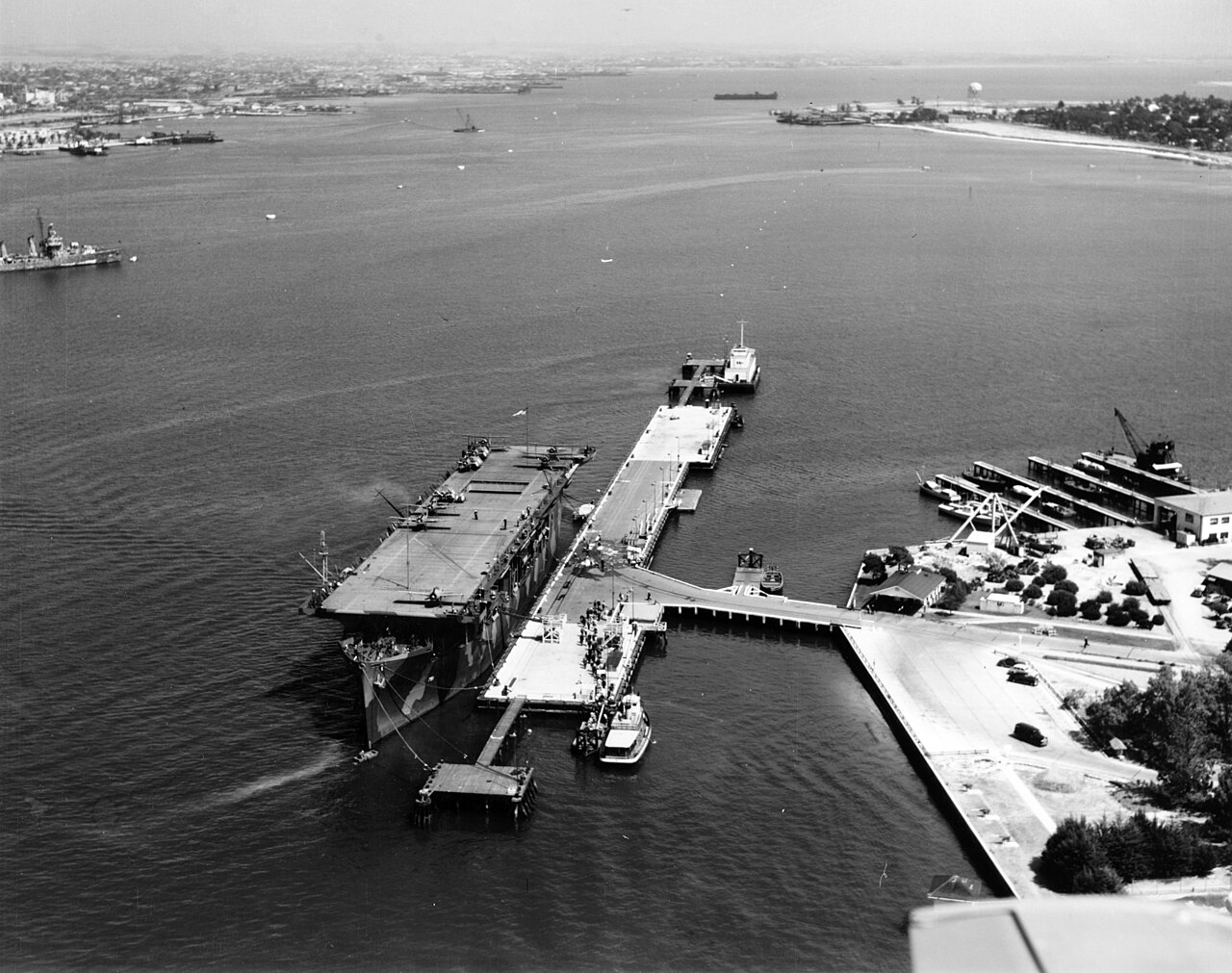
|
|
lordroel
Administrator
Member is Online
Posts: 68,107 
Likes: 49,494
|
Post by lordroel on Jun 3, 2021 2:46:33 GMT
Day 999 of World War II, June 3rd 1942Continuation WarPhoto: Finnish Lahti L-39 anti-tank gun in use Battle of the Atlantic Battle of the Atlantic In the Atlantic 400 miles East of Guyana, U-126 attacks Norwegian tanker MV Høegh Giant all day, finally sinking her at 1.40 AM next morning (all 39 hands survive but have a long and harrowing return to safety). 40 miles off the Western end of Nova Scotia, U-432 sinks 2 tiny unarmed US fishing boats with shellfire, after allowing the crews to escape. At 9.56 PM 150 miles Northwest of Trinidad, U-502 sinks US tanker SS MF Elliott (13 killed; 27 survivors picked up at dawn next day by US destroyer USS Tarbell; 2 survivors are questioned on board U-502 for 3 hours, put on a raft with provisions and picked up 5 days later by Brazilian tanker SS Santa Maria). Battle of the Caribbean400 miles Northeast of San Juan, Puerto Rico, U-172 torpedoes American SS City of Alma which sinks immediately on her cargo of 7400 tons of manganese ore (29 killed, 10 survivors picked up 4 days later by American patrol boat USS YP-67). At 9.26 AM, U-156 sinks British schooner Lillian (running passengers and rum between Caribbean islands) with 322 rounds of gunfire (3 dead, 22 survivors). From 5 AM to 10 AM 245 miles Northwest of Bermuda, U-404 attacks and sinks neutral Swedish SS Anna (all 17 hands rescued). Air War over Europe Overnight, RAF 170 aircraft bombers attack Bremen, Germany, causing damage to housing, the harbour and German destroyer Z-25 (83 dead, 258 injured, 4 Wellingtons, 2 Halifaxes, 2 Lancasters, 2 Stirlings, 1 Manchester lost). Luftwaffe bombers attack Poole, England. United States
Photo: USS North Carolina off Norfolk Navy Yard, Portsmouth, Virginia, United States, 3 June 1942
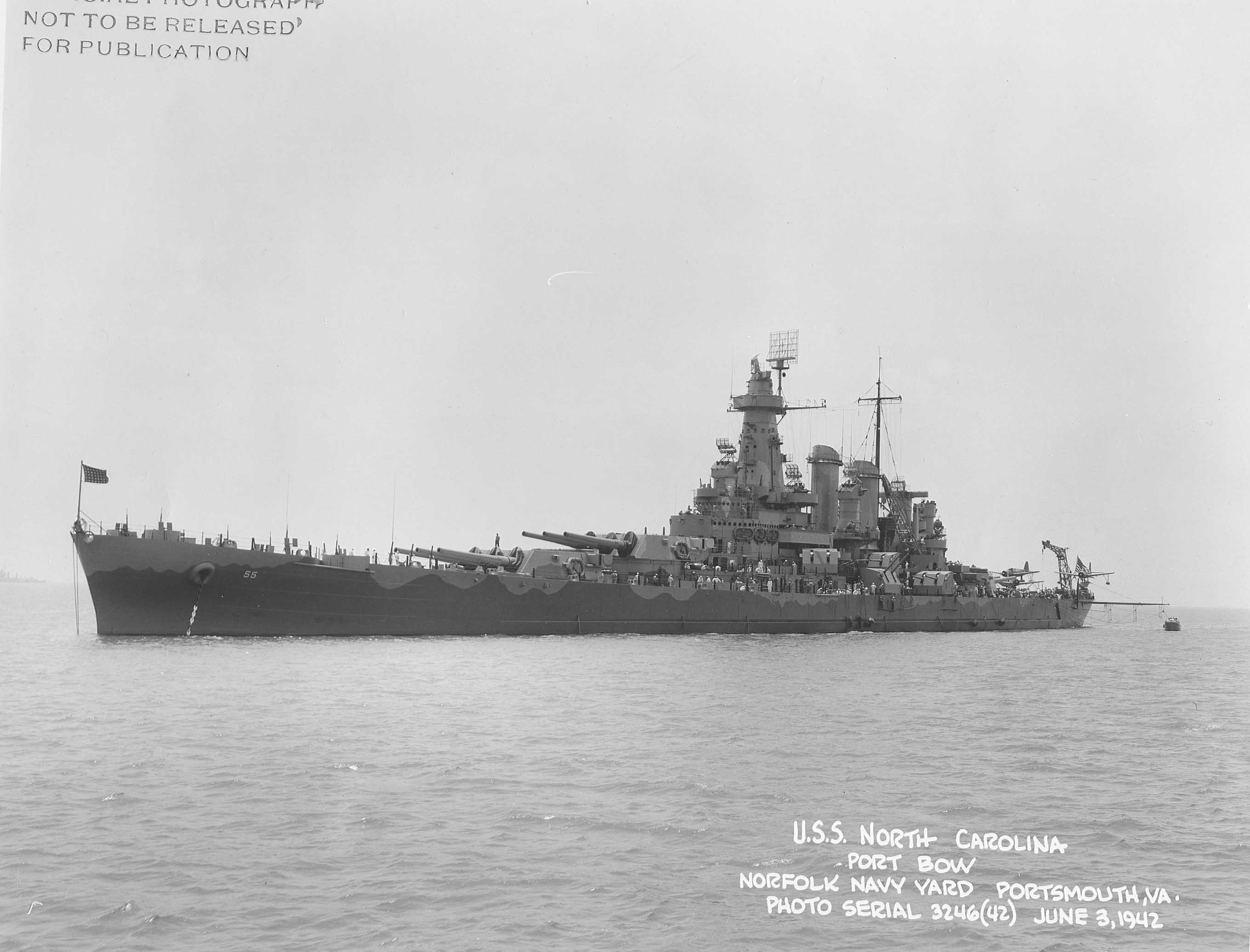 .jpg?type=w800)
Photo: The U.S. Navy light cruiser USS San Juan (CL-54) off Norfolk, Virginia (USA), 3 June 1942 Pacific War Pacific War MIDWAY OPERATIONS In the morning, US Catalina PBY seaplanes from Midway spot elements of the Japanese fleet, providing crucial information on location, direction and speed. At 12.30 PM, 9 US B-17 bombers take off from Midway and bomb Japanese troop transport ships 660 miles West of Midway 3 hours later but score no hits n the face of heavy anti-aircraft fire from the escorts. Diorama: depicting the sighting of the Japanese minesweepers Tama Maru No. 3 and Tama Maru No. 5 by a Midway-based Consolidated PBY Catalina flown by Ensign James P.O. Lyle, at 0904 hrs on 3 June 1942. These ships had left Wake on 31 May, and were the first units of the Japanese invasion force to be spotted enroute to Midway
 ALEUTIAN ISLANDS CAMPAIGN - BATTLE OF DUTCH HARBOR Japanese occupy Kiska and Attu in the Aleutians. Despite dense fog and rough seas, the Japanese light aircraft carriers Junyo and Ryujo, supported by the heavy cruisers Takao and Maya, three destroyers and an oiler, begin launching aircraft at 0325 hours local against Dutch Harbor on Unalaska Island, Aleutian Islands. This is part of the "AL" Operation. Only half of the aircraft reach the objective; the other half either crash into the sea or return to their ships. At 0545 hours, 15 aircraft appear and begin strafing targets at naval installations at Dutch Harbor and the Army's Fort Mears; at 0555 hours, the first of four waves of bombers in groups of three or four, Nakajima B5N, Navy "Kate," Bombers, Allied Code Name release 16 bombs on Fort Mears killing 25 and wounding many others. P-40s from Cold Bay trying to intercept them arrive 10 minutes after the last attack wave departs. Other P-40s at Otter Point Field on Umnak Island are notified too late due to communication failure. Photo: Japanese bomb exploding in the water at Dutch Harbor, US Territory of Alaska, 3 June 1942  Photo: U.S. Marines on alert at Dutch Harbor after the Japanese air attacks on June 3, 1942 Photo: U.S. Marines on alert at Dutch Harbor after the Japanese air attacks on June 3, 1942 The Japanese cruisers had catapulted four Nakajima E8N2 Navy Type 95 Reconnaissance Seaplanes, Allied Code Name "Dave," to reconnoiter the area west of Dutch Harbor and two of them flew over Umnak and one was shot down and the other was damaged and retreated still unaware of the new airdrome. By 0745 hours local, the Japanese carriers had recovered their aircraft. Meanwhile, nine P-40s and six B-26's fly a patrol but cannot find the fleet, 180 miles south of Dutch Harbor. Photo: Buildings burning after the first enemy attack on Dutch Harbor, 3 June 1942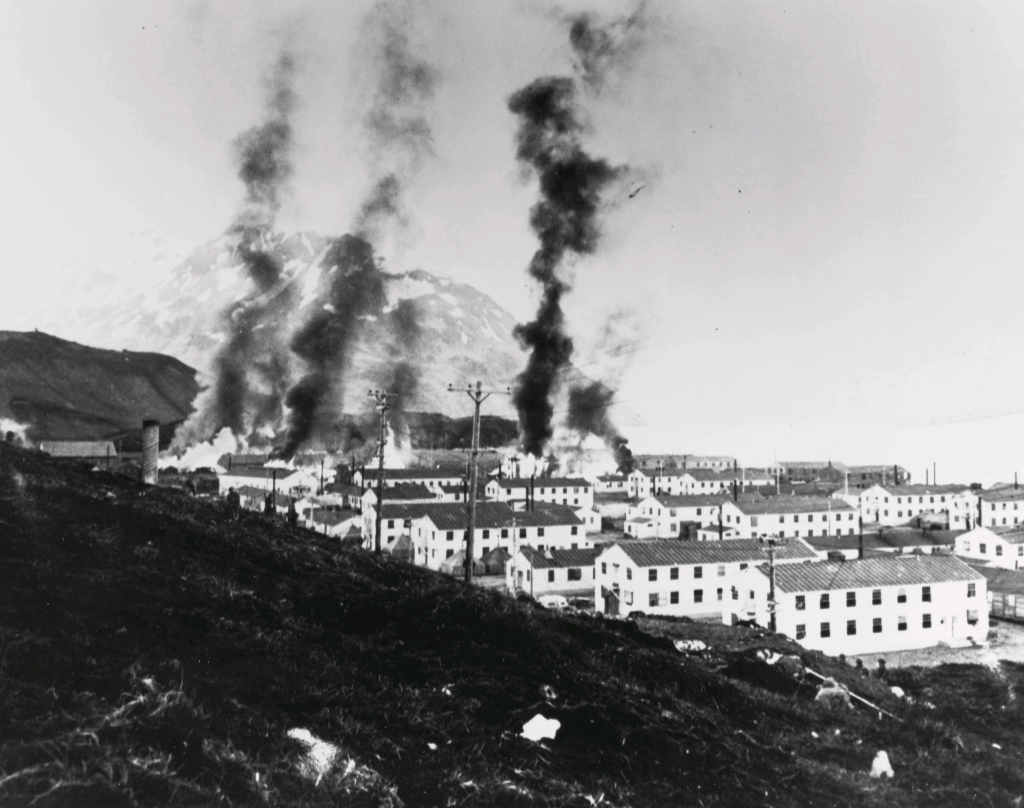 However, a PBY-5A Catalina of the USN's Patrol Squadron VP-42 flies through a snow squall and locates the Japanese ships. The aircraft is attacked by Japanese fighters but the Americans linger in the area until the composition and position of the force can be determined. The PBY finally heads for home but runs out of fuel and makes an open sea landing where the crew is rescued by the U.S. Coast Guard cutter USCGC Nemaha. Another PBY-5A of VP-41 searching for the Japanese are shot down and three are captured and taken aboard the cruiser Takao. The Japanese torture the three in an attempt to learn the location of the unknown USAAF base but the sailors reveal nothing. The three are taken to Japan and survive their internment. One "Zeke," is damaged by AA fire and the pilot makes an emergency landing on Akutan Island. However, he was fooled by the flat surface; it is actually a bog and the aircraft flips over killing the pilot. The recovery of this aircraft in July 1942 reveals many of its secrets. Six B-17Es equipped with SCR-521 radar arrive at Kodiak and are immediately dispatched on search missions to locate the Japanese ships. Additional losses in the Aleutians: 26 Army and 1 Navy were killed, and four quonset huts, one barracks building, and one radio tower were destroyed. All but one of the carrier-based air returned safely but two of four Pete float planes were shot down late in the day when they were ambushed by P-40's from Cold Bay. Anti-aircraft fire from the few US Navy weapons was heavy but ineffective due to the siting of the weapons. The US Army's 206th CA (AA) was ashore and well-sited but the commander refused to allow it to open fire from concerns about revealing its location. Accurate fire was returned from the SS PRESIDENT FILLMORE, moored in the harbor, which had G/260th CA (AA) (often but inaccurately listed as G/503rd CA (AA) on board with its guns on deck through the foresight of then 1st Lt Perry Faust. The Port Captain later credited this unit for its performance and noted that he had thought the ship had exploded, so heavy was the fire being returned from the ship. The Port Engineer had only recently completed the pier at Dutch Harbor, a example of really solid engineering due to the extreme depth of the harbor. He ran along the dock during the attack and continued to order all moored vessels to set sail lest the Japanese damage "his" pier. He was ignored by the ship's captains. CHINA-BURMA-INDIA THEATER OF OPERATIONS (10th Air Force): A flight of 6 B-25s of the 11th Bombardment Squadron, 7th BG, earmarked for China, take off from Dinjan, India for China. They bomb Lashio, Burma en route to Kunming, but afterward 9 crash into an overcast-hidden mountain at 10,000 feet and another is abandoned when it runs out of fuel near Chan-i, China. The remaining 2 B-25's reach Kunming, China, 1 with its radio operator killed by a fighter. SOUTHWEST PACIFIC AREA (5th Air Force): B-17s hit the wharf, warehouse area, and military camp at Rabaul.
|
|
lordroel
Administrator
Member is Online
Posts: 68,107 
Likes: 49,494
|
Post by lordroel on Jun 4, 2021 3:17:49 GMT
Day 1000 of World War II, June 4th 1942Battle of the AtlanticEarly in the morning 750 miles Northeast of Natal, Brazil, German armed merchant cruiser Stier attacks British SS Gemstone ‘out of the sun’. After the crew is taken on board, Stier sinks SS Gemstone, which is carrying iron ore from South Africa to USA, with a torpedo. Battle of the Caribbean20 miles off the Western end of Cuba, U-159 sinks Norwegian SS Nidarnes (13 killed, 11 survivors picked up by an American ship). Pacific War HAWAII ISLAND CAMPAIGN - BATTLE OF MIDWAY At 4.30 AM, Japanese carriers launch 72 bombers and 36 Zero fighters to destroy the airfield at Midway but they are detected by a US reconnaissance seaplane 150 miles from Midway and tracked by American radar. Midway launches fighters to intercept and sends unescorted bombers to attack the Japanese fleet. Japanese win the aerial battle over Midway. Diorama: The Japanese carrier air attack on Midway in the morning of 4 June 1942. Two Mitsubishi Type 00 (Zero)carrier fighters are at left. Eastern Island airfield is under attack in lower center. Sand Island is in the upper left center, with hits visible in the vicinity of the seaplane hangar At 6.20 AM but the bombers find no US aircraft on the ground and do relatively little damage to the airfield so another aerial attack is needed before troops go ashore (and to protect the Japanese fleet). Bombers waiting on the Japanese carriers to attack US warships, armed with torpedoes, are sent below to re-arm with bombs to finish off Midway. Photo: Damage on Sand Island, Midway, following the Japanese air attack delivered on the morning of 4 June 1942. This view, probably photographed from the power-plant roof, looks roughly south west, along what was then Sand Island's southern shore. Building in the foreground is the laundry, which was badly damaged by a bomb. Oil tanks are burning in the distance. Note pilings and surf in the left distance
 Photo: Burning oil tanks on Sand Island, Midway, following the Japanese air attack delivered on the morning of 4 June 1942. These tanks were located near what was then the southern shore of Sand Island. This view looks inland from the vicinity of the beach. Three Laysan Albatross ("Gooney Bird") chicks are visible in the foreground Photo: Burning oil tanks on Sand Island, Midway, following the Japanese air attack delivered on the morning of 4 June 1942. These tanks were located near what was then the southern shore of Sand Island. This view looks inland from the vicinity of the beach. Three Laysan Albatross ("Gooney Bird") chicks are visible in the foreground At 7 AM, US carriers USS Enterprise and USS Hornet (Task Force 16) launch all their torpedo and dive bombers towards the Japanese warships and USS Yorktown launches an hour later. Photo: Flight deck of USS Hornet (CV-8) on the morning of 4 June 1942. Aircraft are spotted and ready to take off for strike on Japanese Kido Butai during Battle of Midway. F4F-4 Wildcats (from left to right) F-21, F-16, F-20, F-24 and F-22 can be identified in the foreground

Photo: The U.S. Navy aircraft carrier USS Enterprise (CV-6) steaming at high speed at about 0725 hrs, 4 June 1942, seen from USS Pensacola (CA-24). The carrier had launched Scouting Squadron Six (VS-6) and Bombing Squadron Six (VB-6) and was striking unlaunched SBD aircraft below in preparation for respotting the flight deck with torpedo planes and escorting fighters. USS Northampton (CA-26) is in the right distance, with SBDs orbiting overhead, awaiting the launch of the rest of the attack group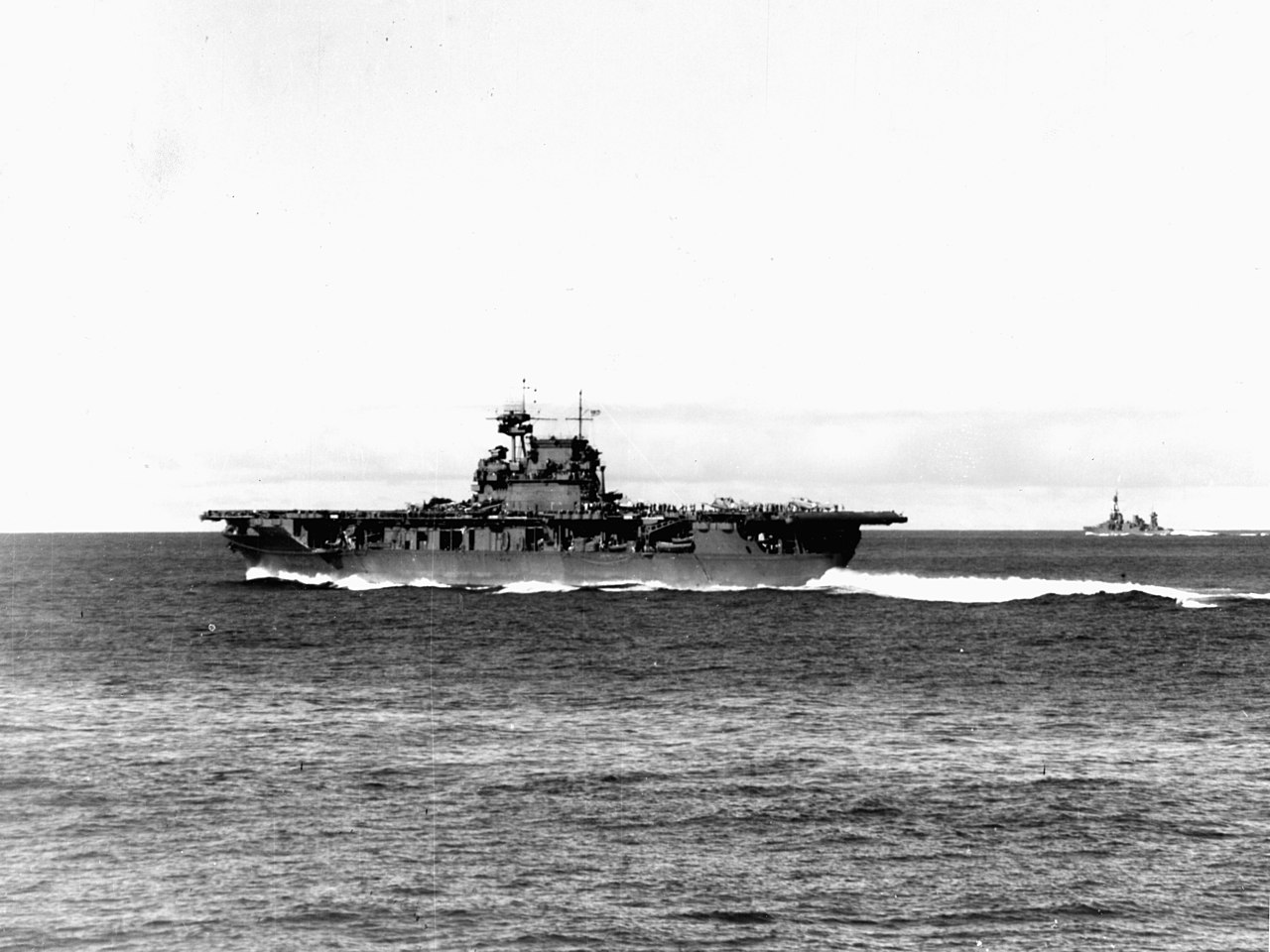 Photo: U.S. Navy Torpedo Squadron 6 (VT-6) Douglas TBD-1 Devastator aircraft are prepared for launching aboard the aircraft carrier USS Enterprise (CV-6) at about 0730-0740 hrs. Eleven of the fourteen TBDs launched from Enterprise are visible. Three more TBDs and ten Grumman F4F-4 Wildcat fighters must still be pushed into position before launching can begin. The TBD in the left front is Number Two (BuNo 1512), flown by Ensign Severin L. Rombach and Aviation Radioman 2nd Class W.F. Glenn. Along with eight other VT-6 aircraft, this plane and its crew were lost attacking Japanese aircraft carriers somewhat more than two hours later. The heavy cruiser USS Pensacola (CA-24) is in the right distance and a destroyer is in plane guard position at left Photo: U.S. Navy Torpedo Squadron 6 (VT-6) Douglas TBD-1 Devastator aircraft are prepared for launching aboard the aircraft carrier USS Enterprise (CV-6) at about 0730-0740 hrs. Eleven of the fourteen TBDs launched from Enterprise are visible. Three more TBDs and ten Grumman F4F-4 Wildcat fighters must still be pushed into position before launching can begin. The TBD in the left front is Number Two (BuNo 1512), flown by Ensign Severin L. Rombach and Aviation Radioman 2nd Class W.F. Glenn. Along with eight other VT-6 aircraft, this plane and its crew were lost attacking Japanese aircraft carriers somewhat more than two hours later. The heavy cruiser USS Pensacola (CA-24) is in the right distance and a destroyer is in plane guard position at left Photo: The U.S. Navy aircraft carrier USS Yorktown (CV-5) underway with her air group on the flight deck, probably about 0630-0730 hrs, following recovery of her morning search and respotting the flight deck with her strike group. Several Douglas SBD Dauntless scout bombers are on deck alongside and forward of the island, with many other planes densely parked aft. Douglas TBD-1 Devastator torpedo bombers are at the flight deck's rear Photo: The U.S. Navy aircraft carrier USS Yorktown (CV-5) underway with her air group on the flight deck, probably about 0630-0730 hrs, following recovery of her morning search and respotting the flight deck with her strike group. Several Douglas SBD Dauntless scout bombers are on deck alongside and forward of the island, with many other planes densely parked aft. Douglas TBD-1 Devastator torpedo bombers are at the flight deck's rear At 8.30 AM, Admiral Nagumo receives surprising news from a reconnaissance aircraft reporting a US carrier, causing him to reverse his orders (bombs to be taken off the bombers and torpedoes put back on). US bombers from Midway and the carriers attack the Japanese fleet in uncoordinated waves, and are dealt with effectively by anti-aircraft fire and Zero fighters. Photo: The Japanese aircraft carrier Akagi and a destroyer (probably Nowaki) maneuvering below thin clouds while under high-level bombing attack by U.S. Army Air Forces Boeing B-17E Flying Fortress bombers, shortly after 0800 hrs. No aircraft are visible on her flight deck and her forward elevator is in the down position. Akagi launched fighters at 0808 hrs and 0832 hrs. The photo was probably shortly taken after the 0808 hrs launch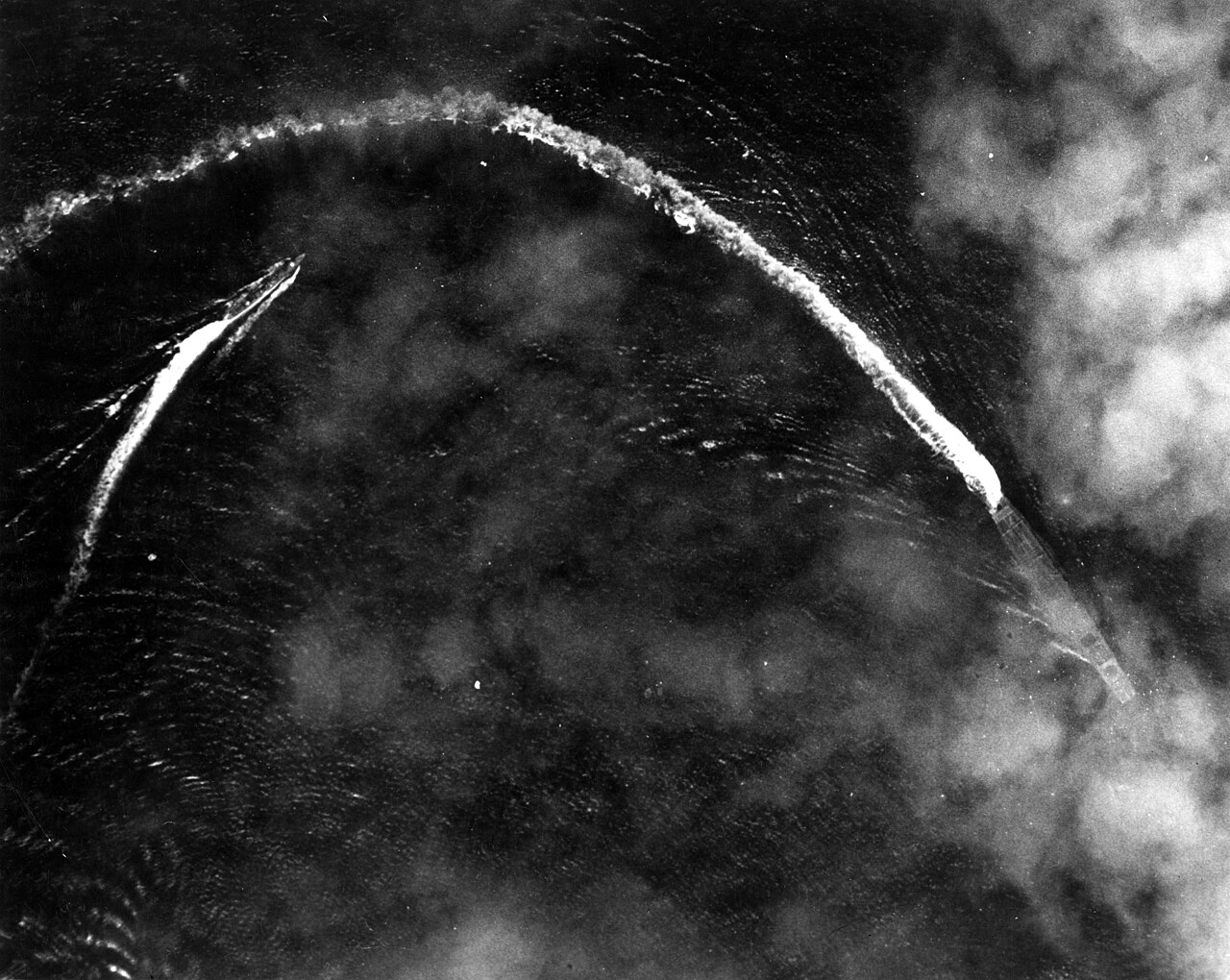 Photo: Aerial photograph of the Japanese aircraft carrier Sōryū and its circular wake. The ship was circling as an evasion maneuver while under attack from United States Army Air Forces Boeing B-17E Flying Fortress bombers from Midway Island, shortly after 08:00h. This attack resulted in near misses, but no hits. The circular wake is approximately 1,160 meters (0.72 miles) in diameter Photo: Aerial photograph of the Japanese aircraft carrier Sōryū and its circular wake. The ship was circling as an evasion maneuver while under attack from United States Army Air Forces Boeing B-17E Flying Fortress bombers from Midway Island, shortly after 08:00h. This attack resulted in near misses, but no hits. The circular wake is approximately 1,160 meters (0.72 miles) in diameter At 10.22 AM, Dauntless SBD dive bombers from USS Enterprise and USS Yorktown attack simultaneously from high altitude while the Zeros are occupied with torpedo bombers. In 5 minutes Japanese carriers Sōryū, Kaga, and Akagi are hit with their flight decks covered with refueling aircraft and piles of bombs and torpedoes, turning the 3 carriers into infernos. Diorama: depicting the attack by USS Enterprise (CV-6) and USS Yorktown (CV-5) dive bombers on the Japanese aircraft carriers Akagi, Kaga and Soryu in the morning of 4 June 1942. The diorama was created during World War II on the basis of information then available. It is therefore somewhat inaccurate in scope and detail. This angle of view depicts Soryu (attacked by Yorktown aircraft) in the middle distance, with Kaga and Akagi (both attacked by Enterprise aircraft) as the closer two burning ships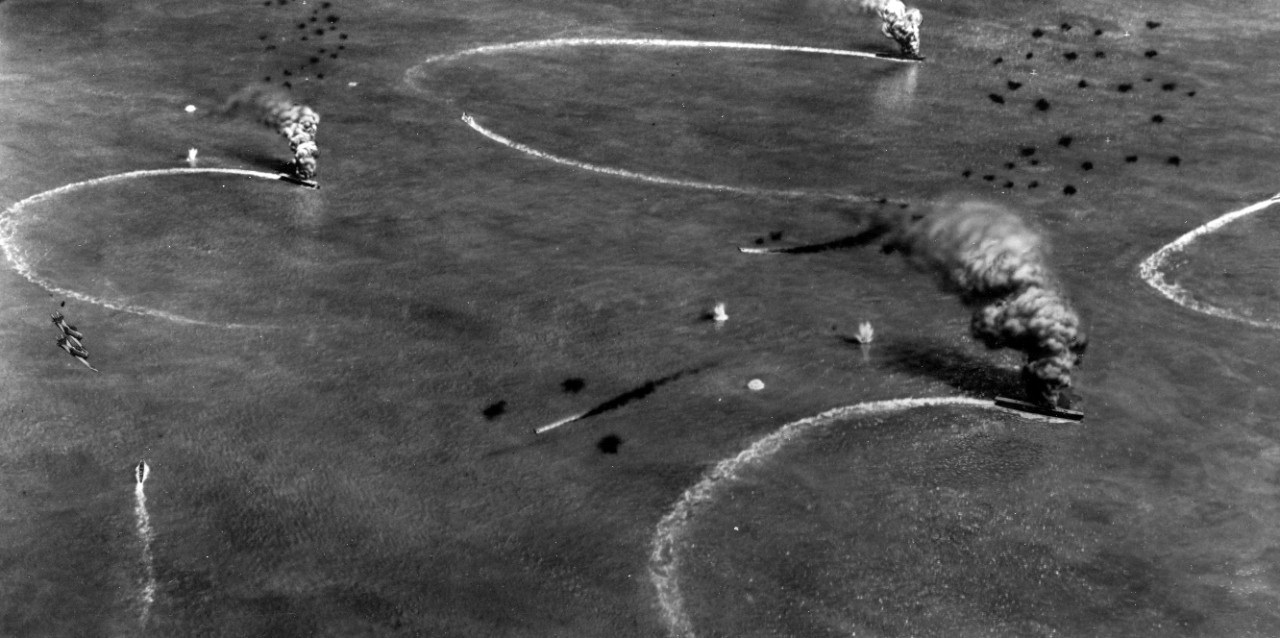 USS Yorktown is hit by dive bombers from the remaining carrier Hiryū at noon, then torpedo bombers from Hiryū immobilize her. Photo: Two Type 97 shipboard attack aircraft from the Japanese carrier Hiryu fly past USS Yorktown (CV-5), amid heavy anti-aircraft fire, after dropping their torpedoes during the mid-afternoon attack, 4 June 1942. Yorktown appears to be heeling slightly to port, and may have already been hit by one torpedo Photo: USS Yorktown (CV-5) is hit on the port side, amidships, by a Japanese Type 91 aerial torpedo during the mid-afternoon attack by planes from the carrier Hiryu, 4 June 1942. Photographed from USS Pensacola (CA-24). Yorktown is heeling to port and is seen at a different aspect than in other views taken by Pensacola, indicating that this is the second of the two torpedo hits she received Photo: USS Yorktown (CV-5) is hit on the port side, amidships, by a Japanese Type 91 aerial torpedo during the mid-afternoon attack by planes from the carrier Hiryu, 4 June 1942. Photographed from USS Pensacola (CA-24). Yorktown is heeling to port and is seen at a different aspect than in other views taken by Pensacola, indicating that this is the second of the two torpedo hits she received Photo: The U.S. Navy aircraft carrier USS Yorktown (CV-5) burning after the first attack by Japanese dive bombers during the Battle of Midway Photo: The U.S. Navy aircraft carrier USS Yorktown (CV-5) burning after the first attack by Japanese dive bombers during the Battle of Midway Photo: Scene on board the U.S. Navy aircraft carrier USS Yorktown (CV-5) during the Battle of Midway, shortly after she was hit by three Japanese bombs on 4 June 1942. Dense smoke is from fires in her uptakes, caused by a bomb that punctured them and knocked out her boilers. A man with hammer at right is probably covering a bomb entry hole in the forward elevator. Note arresting gear cables and forward palisade elements on the flight deck; CXAM radar antenna, large national ensign and YE homing beacon antenna atop the foremast; 12.7 cm/38, 12.7 mm caliber and 28 mm guns manned and ready at left. The heavy cruiser USS Astoria (CA-34) is visible on the left Photo: Scene on board the U.S. Navy aircraft carrier USS Yorktown (CV-5) during the Battle of Midway, shortly after she was hit by three Japanese bombs on 4 June 1942. Dense smoke is from fires in her uptakes, caused by a bomb that punctured them and knocked out her boilers. A man with hammer at right is probably covering a bomb entry hole in the forward elevator. Note arresting gear cables and forward palisade elements on the flight deck; CXAM radar antenna, large national ensign and YE homing beacon antenna atop the foremast; 12.7 cm/38, 12.7 mm caliber and 28 mm guns manned and ready at left. The heavy cruiser USS Astoria (CA-34) is visible on the left At 2.40 PM (Yorktown abandoned at 2.55 PM, although remaining afloat listing badly). Photo: The U.S. Navy aircraft carrier USS Yorktown (CV-5) being abandoned by her crew after she was hit by two Japanese Type 91 aerial torpedoes, 4 June 1942. The destroyer USS Balch (DD-363) is standing by at right. Note the oil slick surrounding the damaged carrier, and inflatable life raft being deployed off her stern. Note that the wartime censor has erased the CXAM-radar aboard Yorktown Photo: The U.S. Navy aircraft carrier USS Yorktown (CV-5) being abandoned by her crew after she was hit by two Japanese Type 91 aerial torpedoes, 4 June 1942. The following destroyers are standing by (l-r): USS Benham (DD-397), USS Russell (DD-414), USS Balch (DD-363) and USS Anderson (DD-411) Photo: The U.S. Navy aircraft carrier USS Yorktown (CV-5) being abandoned by her crew after she was hit by two Japanese Type 91 aerial torpedoes, 4 June 1942. The following destroyers are standing by (l-r): USS Benham (DD-397), USS Russell (DD-414), USS Balch (DD-363) and USS Anderson (DD-411) Photo: The U.S. Navy destroyer USS Benham (DD-397), with 720 survivors of the aircraft carrier USS Yorktown (CV-5) on board, closes the heavy cruiser USS Portland (CA-33) at about 1900 hrs. A report of unidentified aircraft caused Benham to break away before transferring any of the survivors to the cruiser and they remained on board her until the following morning. Note Benham's oil-stained sides. The abandoned Yorktown is visible in the right distance Photo: The U.S. Navy destroyer USS Benham (DD-397), with 720 survivors of the aircraft carrier USS Yorktown (CV-5) on board, closes the heavy cruiser USS Portland (CA-33) at about 1900 hrs. A report of unidentified aircraft caused Benham to break away before transferring any of the survivors to the cruiser and they remained on board her until the following morning. Note Benham's oil-stained sides. The abandoned Yorktown is visible in the right distance At 5.03 PM, Hiryū is set on fire from bow to stern by 4 1000-lb bombs from SBD dive bombers (USS Enterprise and USS Yorktown). In the final act, Sōryū sinks. At 7.13 PM (711 killed, including Captain Yanagimoto who chooses to go down with his ship, 392 taken off by the destroyers Isokaze and Hamakaze) and Kaga is scuttled. At 7.25 by destroyer Hagikaze (811 killed, 900 taken off by destroyers Hagikaze and Maikaze). Map: Movements during the battle, according to William Koenig in Epic Sea Battles YouTube (The Battle of Midway by John Ford, 1942) YouTube (The Battle of Midway by John Ford, 1942)
CHINA-BURMA-INDIA THEATER OF OPERATIONS (10th Air Force): 2 heavy bombers bomb Rangoon, Burma, but are attacked by 10 fighters; 1 heavy bomber is shot down and the other badly damaged. This raid ends 2 months of harassing strikes against Rangoon; soon all heavy bombers are grounded by the monsoons. 11th Bombardment Squadron (Heavy), 7th Bombardment Group (Heavy), is established at Kunming, China with B-25s. ALEUTIAN ISLANDS CAMPAIGN - BATTLE OF DUTCH HARBOR It is rainy with a low-overcast limiting visibility and the two Japanese light aircraft carriers, Junyo and Ryujo, wait for it to clear. Finally, planes are dispatched to bomb Dutch Harbor in weather so poor that only the best pilots on the two ships were permitted to fly. Eleven "Val's" ten "Zero's" and eight "Kate's" attack Dutch Harbor in several waves beginning at 1800 hours local; the fighters make a strafing attack followed by the eleven "Vals" that hit four fuel tanks igniting 22,000 barrels of fuel, demolish part of the naval hospital and damage a beached barracks ship. At 1821 hours, three "Kates" attack but do not do any damage; this was followed by five more "Kates" at 1825 hours which hit an AA emplacement killing four U.S. sailors. U.S. Army and Navy casualties during the two days are 43 killed and approximately 50 wounded. After the attack, the eight "Vals" and "Zekes" from the carrier Junyo, unaware of the USAAF's new fighter base at Otter Point on Umnak Island, rally at the west end of Umnak and are met by eight P-40s which shoot down two "Vals" and two "Zekes." One other plane from Junyo fails to return but all of the aircraft from Ryujo return to the ship. A PBY-5A Catalina of the USN's Patrol Squadron Forty Two locates the Japanese force by radar and circles it for an hour radioing its position. A torpedo attack is made by three B-26's but none of the ships are hit. Photo: Barracks ship Northwestern engulfed by flames in Dutch Harbor after the second Japanese airstrike, June 4, 1942 Photo: Burning oil tanks at Dutch Harbor, Alaska (USA), during the Japanese attack on 4 June 1942 Photo: Burning oil tanks at Dutch Harbor, Alaska (USA), during the Japanese attack on 4 June 1942
 Photo: The beached SS Northwestern and oil tanks burning at Dutch Harbor, Alaska (USA), during the Japanese attack on 4 June 1942 Photo: The beached SS Northwestern and oil tanks burning at Dutch Harbor, Alaska (USA), during the Japanese attack on 4 June 1942
|
|
lordroel
Administrator
Member is Online
Posts: 68,107 
Likes: 49,494
|
Post by lordroel on Jun 5, 2021 6:36:35 GMT
Day 1001 of World War II, June 5th 1942YouTube (145a - Midway, pt.1 - Clash of the Titans - June 5, 1942)Eastern FrontSevastopol - Germans continue to soften up the Soviet defenders with artillery bombardment and Luftwaffe bombing. German 800mm railway gun Schwerer Gustav is brought up and fires 6 shells (weighing 4,800kg with an explosive load of 700kg capable of creating a crater 10m wide by 10 m deep) at Fort Stalin and another 8 shells Soviet coastal gun batteries at a range of 25km. North African campaignLibya - After interminable delay, General Ritchie finally sends massed armor of British 8th Army against Rommel in the Cauldron (Operation Aberdeen). At 3 AM a misdirected artillery barrage falls in empty desert and serves only warn the Germans of the impending attack. When Ritchie’s tanks move forward with British and Indian infantry, the German anti-tank guns are ready and quickly break up the attack. Rommel goes on the attack in the afternoon, overrunning the headquarters of 2 British Divisions as well as 9th and 10th Indian Infantry Brigades. Battle of the Atlantic Free French submarine Rubis lays mines in the Bay of Biscay which will sink French ship Quand Meme (on June 26) and Kriegsmarine minesweepers M-4212 (June 12) and M-4448 (July 10). 650 miles East of St. John’s, Newfoundland, U-94 sinks neutral Portuguese sailing ship Maria da Glória with the deck gun (2 killed immediately). 42 crew escape in 9 dories; 8 are rescued on July 15 by US Coast Guard yacht USCG Sea Cloud but 34 others are never found. Battle of the Caribbean 15 miles off Cancun, Mexico, U-158 torpedoes American SS Velma Lykes which sinks within a minute (15 killed, 17 survivors). At 6.08 AM 120 miles North of Puerto Rico, U-172 sinks American SS Delfina (4 dead, 27 survivors). At 8.49 PM Dominican Republic, U-68 hits US tanker SS LJ Drake with 3 torpedoes causing the cargo of 72,961 barrels of gasoline to explode (all 40 hands killed immediately). U-159 shoots up 2 sailing boats with the 20mm anti-aircraft gun 85 miles South of Punta Cana (Brazilian schooner Paracury at 5.27 AM and Honduran vessel Sally at 8.10 PM). Pacific War HAWAII ISLAND CAMPAIGN - BATTLE OF MIDWAY The aircraft carriers Akagi and Hiryu, which were damaged yesterday and left drifting, are scuttled by Japanese destroyers. Photo: The burning Japanese aircraft carrier Hiryu, photographed by a Yokosuka B4Y aircraft from the carrier Hosho shortly after sunrise on 5 June 1942. Hiryu sank a few hours later. Flight deck torn out by the bomb dropped during a dive-bombing attack performed by Norman Kleiss Photo: The burning Japanese aircraft carrier Hiryu, photographed by a Yokosuka B4Y aircraft from the carrier Hosho shortly after sunrise on 5 June 1942. Hiryu sank a few hours later. Note collapsed flight deck at right. Part of the forward elevator is standing upright just in front of the island, where it had been thrown by an explosion in the hangar Photo: The burning Japanese aircraft carrier Hiryu, photographed by a Yokosuka B4Y aircraft from the carrier Hosho shortly after sunrise on 5 June 1942. Hiryu sank a few hours later. Note collapsed flight deck at right. Part of the forward elevator is standing upright just in front of the island, where it had been thrown by an explosion in the hangar While turning to avoid the submarine USS Tambor, the heavy cruisers Mogami and Mikuma collide and are damaged. Later in the day, six SBD-2 Dauntlesses and six SB2U-3 Vindicators of Marine Scout Bombing Squadron Two Hundred Forty One attack Mikuma but do not score any hits. Photo: Bridge view of Mogami's damaged bow, following her collision with Mikuma at Midway. The tanker Nichiei Maru is seen ahead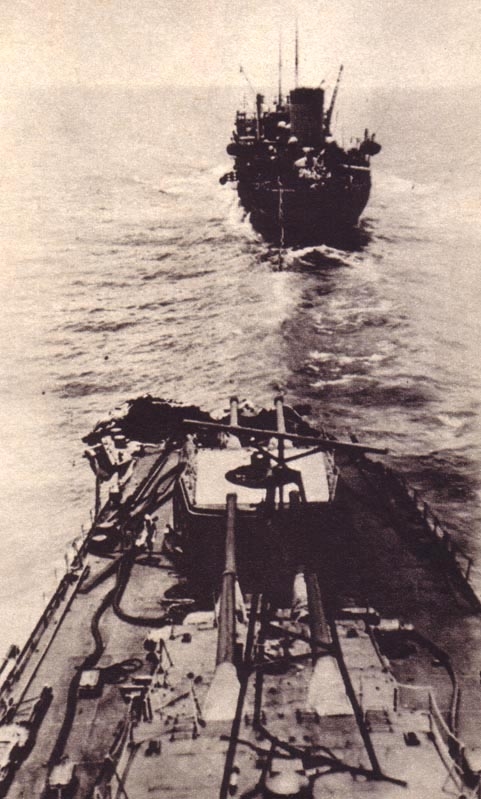 A salvage party of 29 officers and 141 enlisted men return to the aircraft carrier USS Yorktown in an attempt to save her. Five destroyers form an antisubmarine screen while the salvage party boards the listing carrier. At Pearl Harbor, Territory of Hawaii: Admiral Chester Nimitz, USN announces the defeat of the Imperial Japanese Naval fleet at the Battle of Midway. The Battle of Midway continues with the Japanese fleet retiring westward. In the morning 8 B-17s hit a force 130 miles from Midway, claiming hits on 2 large warships. During the afternoon 6 B-17's claim hits on a heavy cruiser 300 miles from Midway. The last strike by Seventh Air Force aircraft in the Battle of Midway is by 5 B-17's which bomb a heavy cruiser 425 miles from Midway. 1 B-17 is shot down and another lost due to fuel shortage. The battle ends with Midway's installations heavily damaged by bombs but still in US hands and with landing strips still intact. During the fighting (3-5 Jun) Seventh Air Force aircraft carried out 16 B-17 attacks (55 sorties) and 1 torpedo attack by 4 B-26's, claiming 22 hits on ships and 10 fighters shot down. 2 B-17's and 2 B-26's were lost. One of the decisive battles of naval history, Midway will cost Japan the initiative and will be a turning point in the Pacific war. ALEUTIAN ISLANDS CAMPAIGN Japanese Naval Headquarters issues an order at 0920 hours local instructing the 2nd Mobile Fleet, the two light aircraft carriers that attacked Dutch Harbor, Alaska, yesterday, to join the 1st Mobile Fleet off Midway and the two carriers begin steaming south. This order is cancelled at 2355 hours. The Japanese also order 1,200 troops of the Adak-Attu Occupation Force to steam towards Attu Island. The USAAF's 11th Air Force dispatches ten B-17's, 18 B-26's and two LB-30's to search for the two aircraft carriers. One radar-equipped B-17E locates the "targets" on radar and bombs; the "targets" were actually the Pribilof Islands. Photo: damaged ship at Dutch Harbor, US Territory of Alaska, 5 June 1942 SOUTHWEST PACIFIC AREA (5th Air Force): B-17s hit wharves, a warehouse, and coal jetty at Rabaul. MOZAMBIQUE CHANNEL Japanese begin commerce raiding in the Mozambique Channel. 350 miles off Durban, South Africa, surface raiders Aikoku Maru and Hokoku Maru sink British liner SS Elysia (which suffered 5 torpedo attacks in WWI without sinking) en route from Glasgow to Bombay. Submarine I-20 sinks Panamanian merchant Johnstown, 100 miles off Pemba, Mozambique. 45 miles off Inhassoro, Mozambique, submarine I-10 sinks Panamanian Atlantic Gulf at 2.31 AM and American freighter Melvin H Baker at 10.44 AM.
|
|
lordroel
Administrator
Member is Online
Posts: 68,107 
Likes: 49,494
|
Post by lordroel on Jun 6, 2021 6:32:38 GMT
Day 1002 of World War II, June 6th 1942YouTube (145b - Germany to Strike Strongest Fortress in the World)Easter Front Sevastopol - Germans continue pounding Soviet defenses with Luftwaffe bombing and artillery bombardment, including 600mm siege mortars Thor and Odin plus 800mm railway gun Schwerer Gustav which fires 7 shells at Fort Molotov and busts "Ammunition Mountain" (an undersea ammunition magazine covered with 10m of concrete, 30m under the sea in Severnaya Bay) with another 9 shells. North African campaignLibya - following the retreat of Allied tanks in the aborted Operation Aberdeen, 3 Indian infantry battalions and 4 artillery regiments left in the Cauldron are overrun by Italian and German troops. With the battle in the Cauldron won, Rommel sends 90th Light Division to assist the assault on the Free French troops at Bir Hacheim fort. Photo: A British M3 Grant tank next to a knocked out a German Panzerkampfwagen I light tank on 6 June 1942 in North Africa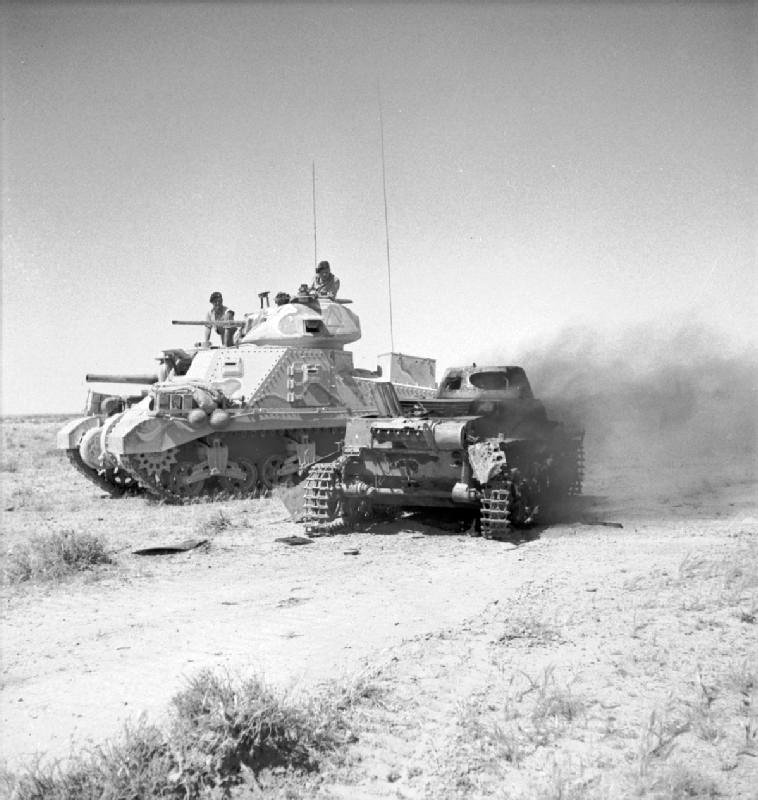 Air War over Europe Air War over Europe Overnight, 233 RAF bombers (124 Wellingtons, 40 Stirlings, 27 Halifaxes, 20 Lancasters, 15 Hampdens, 7 Manchesters) attack Emden, Germany (300 houses destroyed, 17 killed and 49 injured). 3 Manchesters, 3 Wellingtons, 2 Stirlings and 1 Halifax are lost. Luftwaffe bombs Canterbury in Southeast England. Battle of the Atlantic Near the equator in the middle of the Atlantic, German armed merchant cruiser Stier attacks Panamanian tanker Stanvac Calcutta which fires back with her 4-inch gun hitting Stier twice. Stier responds with 123 rounds from the 6-inch gun, scoring 40 hits and sinking Stanvac Calcutta (12 killed, 36 crew taken prisoner). In the South Atlantic, speedboat Esau from German armed merchant cruiser Michel torpedoes US liberty ship SS George Clymer (carrying 24 US aircraft). George Clymer stays afloat badly damaged and is scuttled next day by British armed merchant cruiser HMS Alcantara, which takes off the crew. Michel intends to attack HMS Alcantara during the rescue operation but mistimes the attack and arrives too late. Battle of the Caribbean 60 miles Southwest of Puerto Rico, U-68 sinks Panamanian tanker MV C.O. Stillman carrying 125,812 barrels fuel oil (3 killed, 55 survivors). Pacific War HAWAII ISLAND CAMPAIGN - BATTLE OF MIDWAY 170 miles North of Midway, US carrier USS Yorktown is still afloat but on fire, under tow by minesweeper USS Vireo. At 4.30 AM, Japanese submarine I-168 penetrates the escort screen of cruisers and destroyers. At 6 AM, destroyer USS Hammann puts a salvage party aboard and remains alongside to provide power. Photo: USS Hornet (CV-8), the light anti-aircraft cruiser USS Atlanta (CL-51), left, and the heavy cruiser USS New Orleans (CA-32), center, and the destroyer USS Phelps (DD-360), right. The photo was taken as Atlanta came up to offer assistance to the Phelps (DD-360) which had broken down temporarily because of fuel shortage Photo: USS Hornet (CV-8) and the light anti-aircraft cruiser USS Atlanta (CL-51). The photo was taken as Atlanta came up to offer assistance to the destroyer USS Phelps (DD-360), which had broken down temporarily because of fuel shortage. Note that the wartime censor has removed Atlanta's radar antenna Photo: USS Hornet (CV-8) and the light anti-aircraft cruiser USS Atlanta (CL-51). The photo was taken as Atlanta came up to offer assistance to the destroyer USS Phelps (DD-360), which had broken down temporarily because of fuel shortage. Note that the wartime censor has removed Atlanta's radar antenna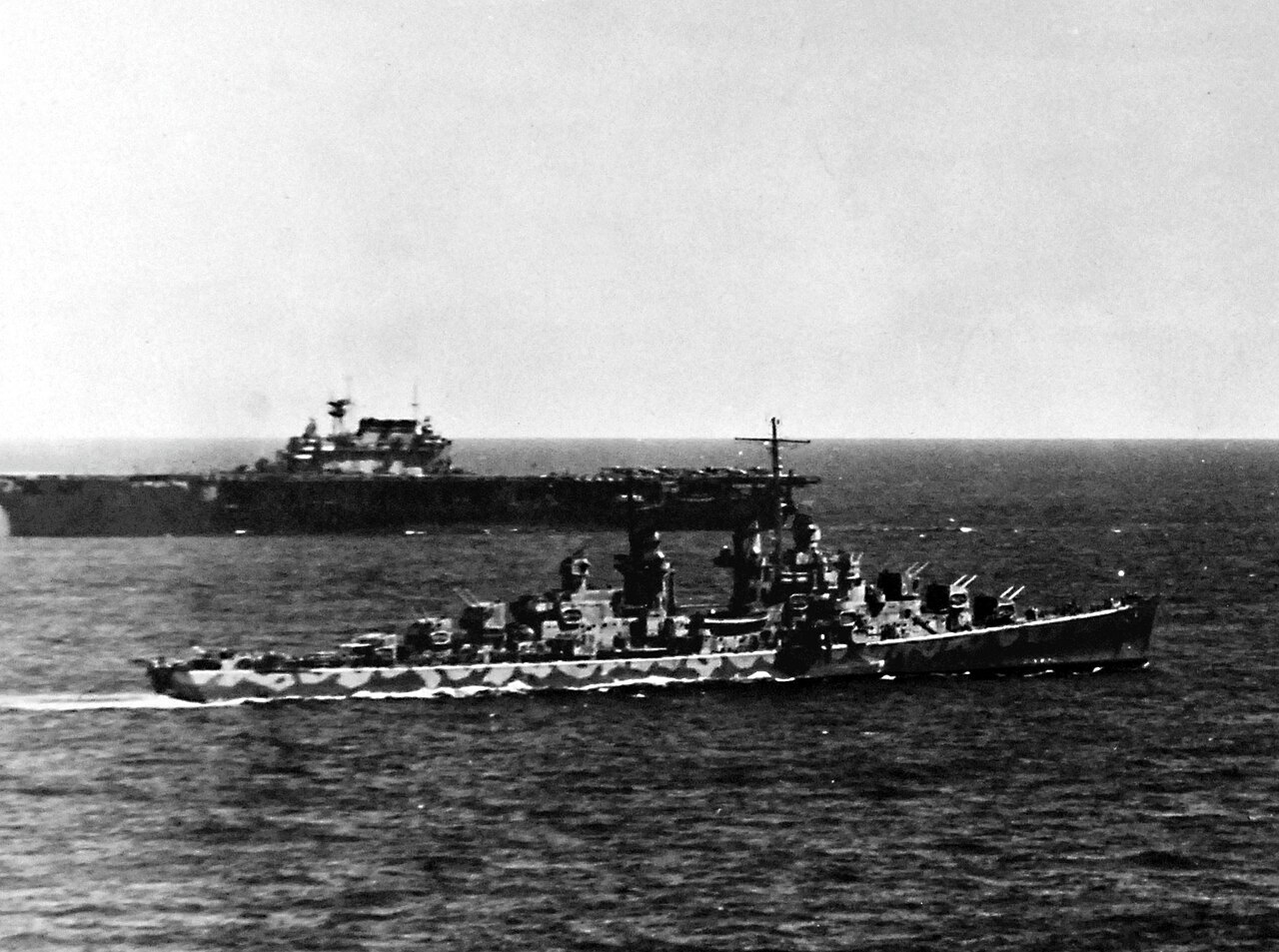 At 1.31 PM, I-168 fires 4 torpedoes hitting USS Hammann which sinks in 4 minutes (84 killed, mainly by her primed depth charges exploding; 104 survivors including 72 wounded rescued by destroyers USS Balch and USS Benham) and USS Yorktown (remains afloat but the salvage party evacuates). US destroyers counterattack, dropping 40 depth charges and causing much damage to I-168 which escapes back to Japan. Photo: USS Hammann (DD-412) sinking with stern high, after being torpedoed by Japanese submarine I-168. Angular structure in right foreground is the front of Yorktown's forward starboard 5-inch gun gallery. Note knotted lines hanging down from the carrier's flight deck, remaining from her initial abandonment on 4 June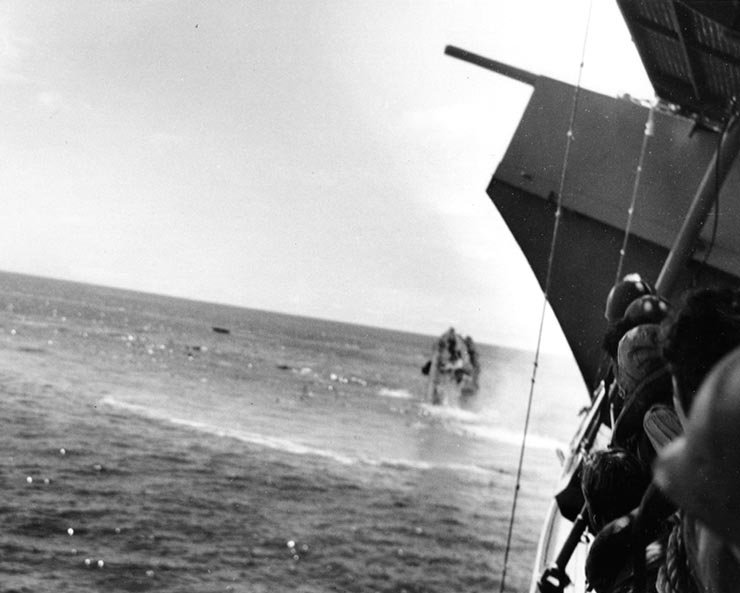 560 miles West of Midway, US reconnaissance aircraft find the cruisers and destroyers reported yesterday by submarine USS Tambor. From 9.45 AM to 2.45 PM, 3 waves of dive-bombers from carriers USS Enterprise and USS Hornet attack, hitting destroyers Arashio (37 killed) & Asashio (22 killed) once each and cruisers Mikuma & Mogami (81 killed) with at least 5 bombs each. Mogami survives having dumped all her ordnance following yesterday’s collision but Mikuma is badly damaged by her own torpedoes exploding and sinks after dark (650 killed, 240 rescued by Mogami, Asashio and Arashio). Photo: U.S. Navy Douglas SBD-3 "Dauntless" dive bombers from scouting squadron VS-8 from the aircraft carrier USS Hornet (CV-8) approaching the burning Japanese heavy cruiser Mikuma to make the third set of attacks on her, during the Battle of Midway, 6 June 1942. Mikuma had been hit earlier by strikes from Hornet and USS Enterprise (CV-6), leaving her dead in the water and fatally damaged. Note bombs hung beneath the SBDs Photo: The Japanese heavy cruiser Mikuma, photographed from a USS Enterprise (CV-6) Douglas SBD-3 Dauntless during the afternoon, after she had been bombed by planes from Enterprise and USS Hornet (CV-8). Note her shattered midships structure, torpedo dangling from the after port side tubes and wreckage atop her number four 203 mm gun turret Photo: The Japanese heavy cruiser Mikuma, photographed from a USS Enterprise (CV-6) Douglas SBD-3 Dauntless during the afternoon, after she had been bombed by planes from Enterprise and USS Hornet (CV-8). Note her shattered midships structure, torpedo dangling from the after port side tubes and wreckage atop her number four 203 mm gun turret PEARL HARBOR, HAWAII Photo: USS Saratoga (CV-3) arrives at Pearl Harbor, Territory of Hawaii, from the U.S. West Coast. She departed the following day to join USS Enterprise (CV-6) and USS Hornet (CV-8) near Midway, bringing replacement aircraft for those two ships, whose air groups had been depleted during the Battle of Midway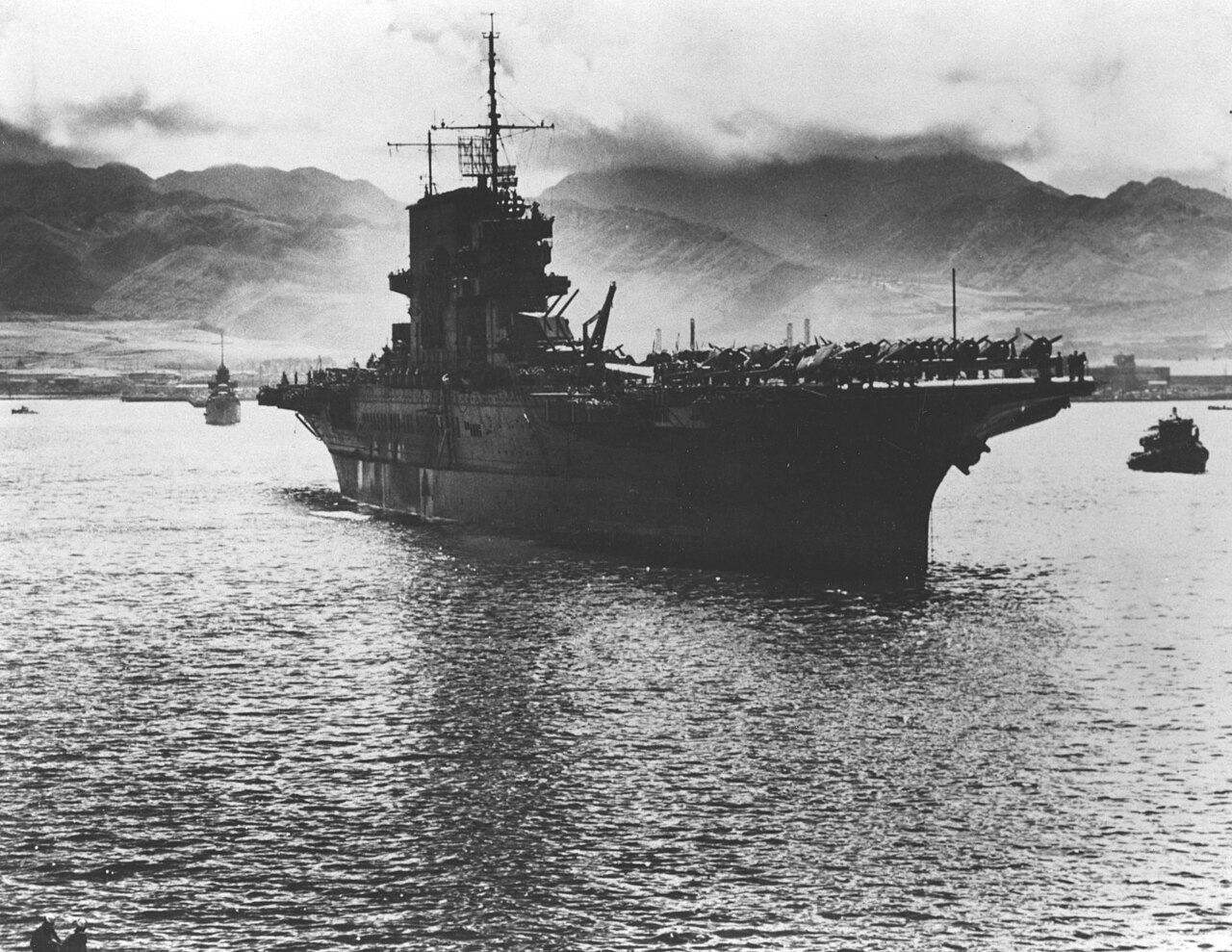 ALEUTIAN ISLANDS CAMPAIGN (11th Air Force): Various bomber search-attack missions are flown in an attempt to contact the fleet reported near Seguam. No contact is made due to weather. 8 P-38's enroute from Cold Bay to Umnak mistakenly attack a Soviet freighter. The Japanese begin to land on Kiska. In the Aleutian Islands, 500 men of the elite Maizura 3rd Special Landing Force and 700 labor troops invade Kiska Island at 1027 hours local. Photo: Japanese troops raise the Imperial battle flag on Kiska Island in the Aleutians on June 6, 1942 The is the first invasion of U.S. territory by a foreign power since the British invaded during the War of 1812. A 10-man USN weather detachment are the only Americans on the island; all ten flee into the hills. The Japanese rename the island Narukami. MOZAMBIQUE CHANNEL Japanese submarine I-16 joins the commerce raiding in the Mozambique Channel, sinking Yugoslavian freighter Susak with the deck gun just of the coast of Mozambique.
|
|
lordroel
Administrator
Member is Online
Posts: 68,107 
Likes: 49,494
|
Post by lordroel on Jun 7, 2021 2:49:38 GMT
Day 1003 of World War II, June 7th 1942YouTube (145c - Midway pt.2 - A New War?)Eastern Front German 11th Army begins the ground assault, under an artillery and aerial barrage, on the heavily-defended Soviet port of Sevastopol on the Crimean peninsula. The main thrust is by German LIV Corps along the Belbek River, Northeast of the city. LIV Corps overruns several strongpoints on the main Soviet defensive line and captures the town of Belbek by 5.15 PM, threatening the nearby Soviet airfield (LIV Corps has 2,357 casualties, including 340 killed). Battle of the Atlantic 700 miles Southwest of Freetown, Sierra Leone, Italian submarine Da Vinci sinks Danish MV Chile (5 killed, 39 rescued). Overnight, a British aircraft in the Bay of Biscay bombs Italian submarine Torelli using radar, causing serious damage to the submarine. Torelli is run aground on the North coast of Spain to prevent sinking and make temporary repairs. Torelli sets off to return to Bordeaux but is bombed and strafed by 2 British Sunderland flying boats (1 killed, 2 wounded). Torelli is again run aground for further repairs, near Santander, until June 14 when she escapes to Bordeaux to avoid internment by the Spanish. Battle of the Caribbean 75 miles South of Sandino, Cuba, U-107 sinks Honduran SS Castilla (24 killed, 35 survivors picked up 6 days later by US Coast Guard patrol vessel USCGC Nike). 50 miles North of Sandino, U-158 sinks Panamanian SS Hermis (1 dead; 46 survivors, including 12 wounded, picked up by US Army transport Toloa). At 10.24 PM 200 miles Southeast of Jamaica, U-159 sinks US SS Edith (2 killed, 29 survivors in 1 lifeboat and 2 rafts land in Jamaica 7 days later). WWI-era minesweeper USS Gannet is acting as a seaplane tender to Patrol Squadron VP-74 at Hamilton, Bermuda. At 7.42 AM 240 miles North of Bermuda, U-653 sinks USS Gannet returning from a search for survivors from British SS Westmoreland sunk on June 1 by U-566 (14 killed; 62 survivors including many injured float on 2 rafts; 2 aircraft from VP-74 land daringly in heavy seas to rescue 22, 40 picked up by US minesweeper USS Hamilton). North African campaignLibya - overnight, German engineers penetrate the minefield at the fort at Bir Hacheim and attack the inner perimeter. They are held by fierce Free French resistance and RAF bombing of the exposed German positions. United StatesPhoto: A U.S. Navy Vought OS2U-2 Kingfisher (BuNo 2244) sits on the sea plane ramp on 7 June 1942 at Naval Air Station Jacksonville, Florida (USA). The color scheme at this time was sky blue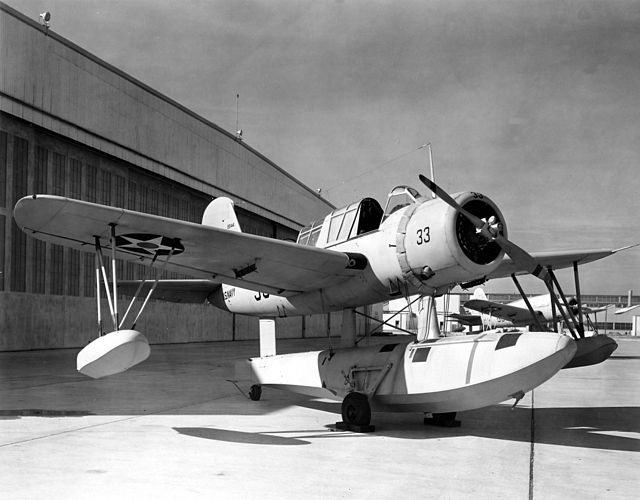 1942 Tribune story implied Americans cracked Japanese code 1942 Tribune story implied Americans cracked Japanese code, Newspaper: Chicago Sunday Tribune, June 7th 1942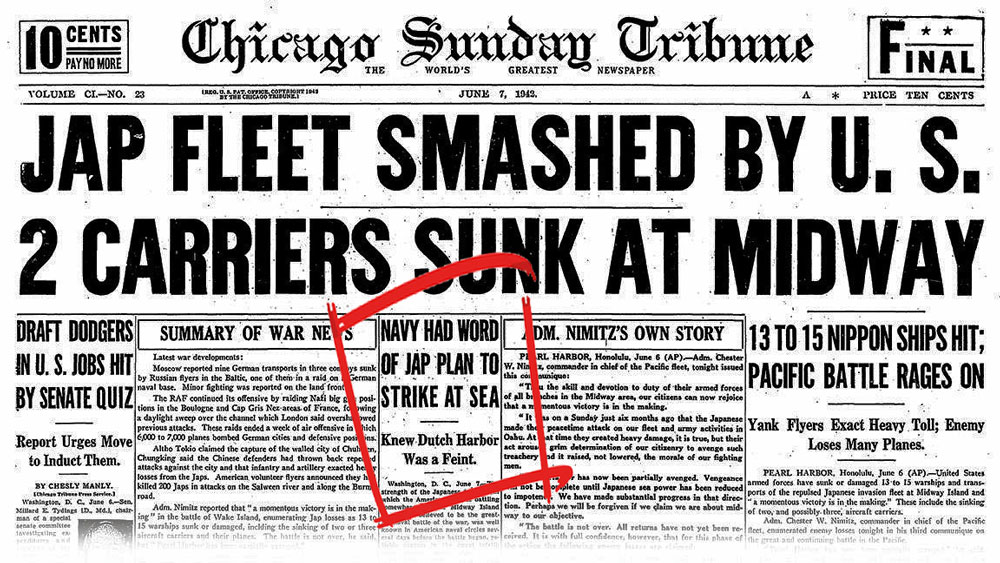 Pacific War Pacific War HAWAII ISLAND CAMPAIGN - BATTLE OF MIDWAY Yesterday’s torpedo damage to USS Yorktown corrected her list from 26o to 17o, raising hopes she can be reboarded and taken in tow. At dawn, Yorktown’s list is seen to be increasing again and she is ceremonially surrounded by her destroyer escort (flags at half mast and crews standing to attention) as she rolls over and sinks at 4.58 AM. Photo: USS Yorktown (CV-5) sinking, just after dawn, as seen from an accompanying destroyer. The ship has capsized to port, exposing the turn of her starboard bilge, with a large torpedo hole amidships severing the forward bilge keel. Yorktown's forefoot is at the extreme right. Her starboard forward 5-inch gun gallery can be seen further up her hull, with two 5"/38 gun barrels sticking out over its edge. The two larger thin objects sticking up, just aft of the 5-inch guns, are aircraft parking outriggers Photo: The U.S. Navy heavy cruiser USS Portland (CA-33), right, transfers survivors of the aircraft carrier USS Yorktown (CV-5) to the submarine tender USS Fulton (AS-11), left, on 7 June 1942, following the Battle of Midway. Fulton transported the men to Pearl Harbor Photo: The U.S. Navy heavy cruiser USS Portland (CA-33), right, transfers survivors of the aircraft carrier USS Yorktown (CV-5) to the submarine tender USS Fulton (AS-11), left, on 7 June 1942, following the Battle of Midway. Fulton transported the men to Pearl Harbor ALEUTIAN ISLANDS CAMPAIGN The 1,143 man Japanese Army's North Sea Detachment, consisting of the 301st Independent Infantry Battalion, the 301st Independent Engineer Company and a service unit, invade Attu Island at 0300 hours local. There are 44 American civilians on the island, 42 Aleut Indians and two Caucasians, Mr. and Mrs. Jones. Charles Jones dies during the invasion, either a suicide or killed by Japanese troops as he attempts to escape. The Aleuts and Mrs. Etta Jones are interned in Japan, the Aleuts at Otaru City on Hokkaido and Mrs. Jones with Australian nurses in Yokohama. Only 24 of the Aleuts and Mrs. Jones survive interment. The Japanese rename the island Atsuta. Nine of the ten USN sailors manning a weather station on Kiska are captured by the Japanese who had discovered the emergency supply caches the sailors had hidden. The tenth man, who was wearing light clothing, evades the Japanese for 48-days surviving on plants and earthworms until forced to surrender after fainting from lack of food. UNITED STATES Photo: USS Hovey (DMS-11) off the Mare Island Navy Yard, California, 7 June 1942. The ship retains her original four tall smokestacks, pre-war type pilothouse and tall foremast. She appears to carry twin 4/50 gun mounts fore and aft and eight .50 caliber anti-aircraft machine guns
|
|
lordroel
Administrator
Member is Online
Posts: 68,107 
Likes: 49,494
|
Post by lordroel on Jun 8, 2021 2:46:42 GMT
Day 1004 of World War II, June 8th 1942Air War over EuropeOvernight, 170 RAF bombers (92 Wellingtons, 42 Halifaxes, 14 Stirlings, 13 Lancasters, 9 Hampdens) attack Essen, Germany. The raid is again inaccurate with bombs scattered over a wide area (13 killed, 42 injured). 7 Wellingtons, 7 Halifaxes, 3 Lancasters, 1 Hampden and 1 Stirling are lost. North African campaignLibya - in the morning under cover of heavy fog, a British convoy reaches the fort at Bir Hacheim to resupply the 1st Free French Division. Rommel has arrived to command the attack, using the same weather to bring up tanks and 88mm guns to fire directly on the fort. General Kesselring provides massive Luftwaffe support, including 42 Stukas. Germans penetrate the outer defenses again and dig in only 200 yards from the fort. Battle of the Atlantic Photo: U.S. Navy Douglas SBD Dauntless dive bombers prepare to take off from the aircraft carrier USS Ranger (CV-4), circa in June 1942. Note the tail of a Grumman F4F-4 Wildcat in the foreground Photo: A U.S. Navy Douglas SBD Dauntless of Bombing Squadron 4 (VB-4) landing on the aircraft carrier USS Ranger (CV-4), circa June 1942. Note the Landing Signal Officer on the right Photo: A U.S. Navy Douglas SBD Dauntless of Bombing Squadron 4 (VB-4) landing on the aircraft carrier USS Ranger (CV-4), circa June 1942. Note the Landing Signal Officer on the right Battle of the Caribbean Battle of the Caribbean 225 miles Northwest of Bermuda, U-135 sinks Norwegian MV Pleasantville (2 dead, 35 crew and 10 US Army engineers in 3 lifeboats rescued by American SS Chickasaw City and Polish MV Paderewski). 400 miles East of Trinidad, U-128 sinks Norwegian tanker MV South Africa (6 dead, 36 survivors in 2 motor lifeboats reach Trinidad 7 days later after declining offers from several merchant vessels to come on board). 100 miles East of Cozumel, Mexico, U-107 sinks American SS Suwied (6 killed, 27 survivors picked up 19 hours later by US Coast Guard patrol vessel USCGC Nemesis). 10 miles South of Cape Beata, Dominican Republic, U-172 sinks US MV Sicilien (44 killed including 19 US Army troops, 31 survivors on rafts reach the Dominican Republic). 100 miles Southeast of Cozumel, U-504 sinks Honduran SS Tela with 2 torpedoes (11 killed, 43 survivors on 2 lifeboats and 2 rafts picked up 12 hours later by British MV Port Montreal) and British SS Rosenborg with 60 rounds from the deck gun (4 killed, 23 survivors picked up by Norwegian MV Geisha). Battle of the Mediterranean At the Eastern end of the Mediterranean, U-83 sinks Egyptian SS Said with 50 rounds from the deck gun 15 miles Southwest of the ancient Palestinian port of Jaffa (5 dead, 9 survivors) and Palestinian sail boat Esther with gunfire 10 miles off Sidon, Lebanon. In the evening 100 miles North of Cape Bon, Tunisia, Italian submarine Alagi mistakenly torpedoes and sinks Italian destroyer Antoniotto Usodimare which is escorting a Rommel supply convoy from Naples, Italy, to Tripoli Libya (survivors rescued by another convoy escort, Italian torpedo boat Cigno). United States/Soviet relations The Soviet Ambassador to the U.S., Maxim M. Litvinov, informs Harry Hopkins, President Roosevelt's assistant, that the Soviet Government has agreed to a Lend-Lease air corridor being established between the Territory of Alaska and Siberia. CanadaThe Royal Canadian Air Force's No. 111 (Fighter) Squadron, equipped with Curtiss Kittyhawk Mk. Is, arrives at Elmendorf Field, Anchorage, Territory of Alaska, as part of the RCAF reinforcements to the USAAF. United KingdomPhoto: The Free French destroyer Léopard, following refit in the United Kingdom in which her forward stack and boilers were removed, fuel stowage increased and additional anti-aircraft guns fitted. Note her British-style pattern camouflage Pacific War Pacific WarALEUTIAN ISLANDS CAMPAIGN The crew of a USN PBY-5A Catalina of Patrol Squadron based at Dutch Harbor, Unalaska Island, Aleutian Islands, spots four transports and two destroyers in Kiska Harbor; flying to Attu Island, they spot the Japanese forces. This is the first indication that the Japanese have occupied these two islands. (11th Air Force): 1 LB-30 flies armed patrol over Kiska and Umnak s and discovers Japanese naval units in Kiska Harbor. NUKU'ALOFA,TONGATAPU Photo: A U.S. Navy Vought OS2U Kingfisher half-way out on the seaplane ramp at Nuku'alofa, Tongatapu, on 8 June 1942. Another Kingfisher is visible in background HAWAII Photo: The U.S. Navy submarine tender USS Fulton (AS-11) unloading survivors of the aircraft carrier USS Yorktown (CV-5) and the destroyer USS Hammann (DD-412) after the Battle of Midway at Pearl Harbor, Oahu, Hawaii (USA), on 8 June 1942 Photo: The U.S. Navy submarine tender USS Fulton (AS-11) docks at Pearl Harbor on 8 June 1942 with USS Yorktown (CV-5) survivors on board, after the Battle of Midway. Among the tugs assisting Fulton are Hoga (YT-146) and Nokomis (YT-142) Photo: The U.S. Navy submarine tender USS Fulton (AS-11) docks at Pearl Harbor on 8 June 1942 with USS Yorktown (CV-5) survivors on board, after the Battle of Midway. Among the tugs assisting Fulton are Hoga (YT-146) and Nokomis (YT-142)
|
|
lordroel
Administrator
Member is Online
Posts: 68,107 
Likes: 49,494
|
Post by lordroel on Jun 9, 2021 2:49:42 GMT
Day 1005 of World War II, June 9th 1942Eastern FrontSevastopol - German 11th Army cannot consolidate its gains against dug in Soviet defenses and LIV Corps takes another 1,700 casualties in fruitless assaults. German troops dig in and allow Luftwaffe and the big guns Thor and Gustav to blast Soviet troops out. Photo: German soldiers of the 11. Armee interrogate civilians in the Crimea![]()  Continuation warPhoto: Erik Lyly in pilot training with a VL Pyry trainer, summer 1941 Continuation warPhoto: Erik Lyly in pilot training with a VL Pyry trainer, summer 1941 Battle of the Atlantic Battle of the Atlantic925 miles East of Ireland, U-124 attacks convoy ONS-100 sinking Free French corvette FFL Mimosa with 2 torpedoes (59 French, mostly from the small Newfoundland island of St. Pierre et Miquelon, and 6 British sailors killed; 4 French sailors picked up by Canadian destroyer HMCS Assiniboine). 100 miles Southwest of Pubnico, Nova Scotia, U-432 fire 4 torpedoes at convoy BX-23A, mildly damaging British MV Malayan Prince (no casualties) but causing major damage to Norwegian MV Kronprinsen (1 killed, towed to Pubnico and beached, then towed to Boston, Massachusetts, in October for repairs). 35 miles Northeast of Cape Blanco, Venezuela, U-502 attacks convoy TO-5 sinking Belgian SS Bruxelles and US tanker SS Franklin K Lane (carrying 73,000 barrels of crude oil, 4 dead and 37 survivors picked up after 3 hours by British destroyer HMS Churchill). Battle of the MediterraneanSouth of Palma, a British PBY Catalina flying boat sinks Italian submarine Zaffiro (all 47 hands lost). British aircraft carrier HMS Eagle from Gibraltar flies off 32 Spitfires fighters to Malta (all arrive safely). HMS Eagle has made 3 runs since early May, bringing 76 Spitfires to Malta to create 5 full squadrons (126, 185, 249, 601, 603 Squadrons) and give RAF air superiority over the Germans and Italians. U-83’s reign of terror on small boats in the Eastern Mediterranean continues, using the deck gun to sink Palestinian sailing ship Typhoon at 11.15 AM 4 miles Southwest of Sidon, Lebanon. North African campaignLibya - Free French 1st Infantry Brigade at Bir Hacheim is desperately low on supplies, with food and ammunition for 1 day and almost no water. In the morning under fog cover, British aircraft drop 34 gallons of water to the fort. At noon, 15th Panzer Division arrives and at 1 PM launches an attack supported by German infantry, under heavy artillery barrage and Luftwaffe bombing by 130 aircraft. The French defenses hold with help of British Bren gun carriers. Realizing the hopeless situation and acknowledging the French determination to hold the Southern end of the Gazala Line, British General Ritchie orders the fort to be evacuated next day. Pacific WarJAPANESE OCCUPIED PHILIPPINE ISLANDS The Japanese declare that the Philippine Islands are secured. MADAGASCAR HMS Ramillies leaves Diego Suarez today, bound for Durban for structural repairs. Her escort on the journey was by the light Cruiser HMS Emerald, three destroyers and a tug. There was much apprehension about the journey due to the extensive damage she had taken, from the Japanese midget submarine attack, and worry about the gaping hole in her side. She arrives at Durban late today having been escorted for the latter part of her journey by HMS Jasmine and HMS Fritillary. She will leave for Cape Town and the UK on the 6th August 1942 arriving back at Plymouth on the 8th September for further repairs at the Devonport Dockyard. She will be out of service for nearly a year. ALEUTIAN ISLANDS CAMPAIGN (11th Air Force): Patrols are flown but encounter no aircraft. PACIFIC OCEAN AREA (7th Air Force): Brigadier General Howard C Davidson, Commanding General VII Fighter Command, also becomes Commanding General 7th Air Force.
|
|






































































.jpg?type=w800)



















































